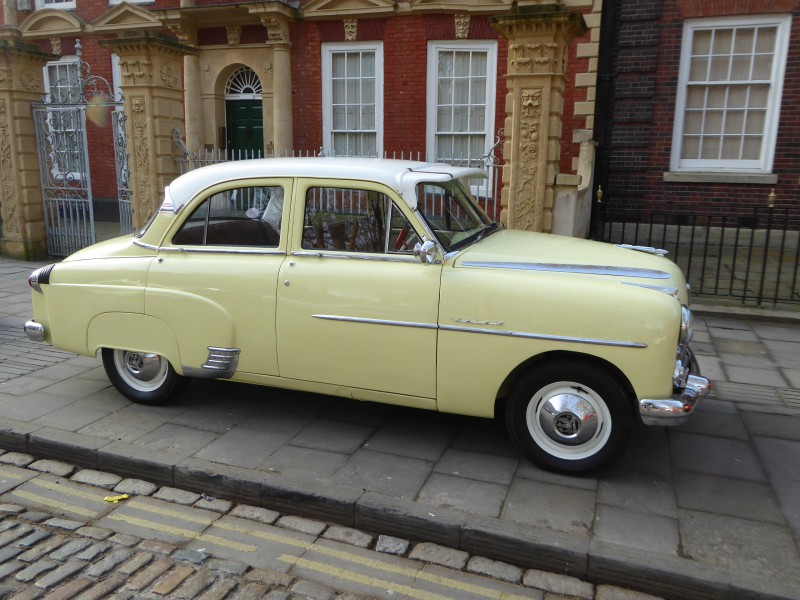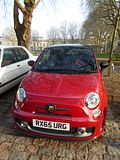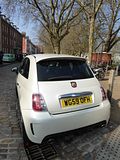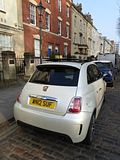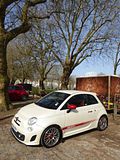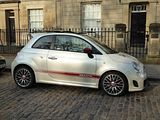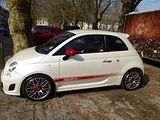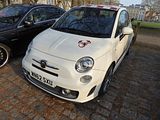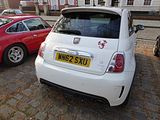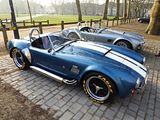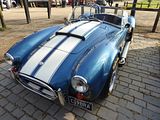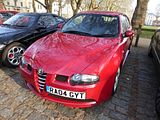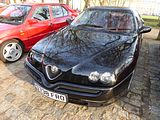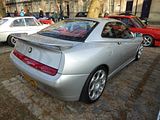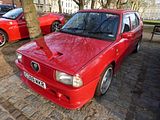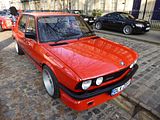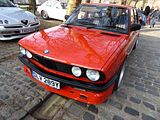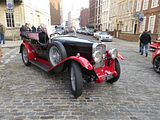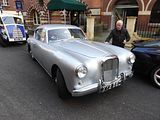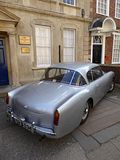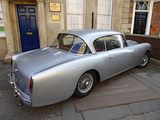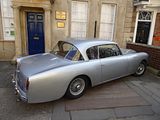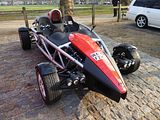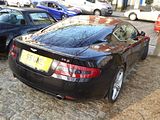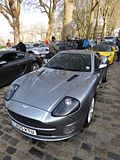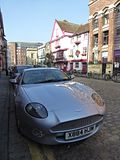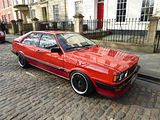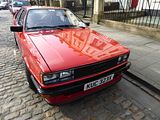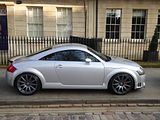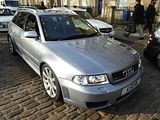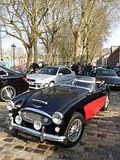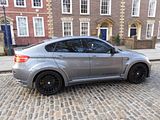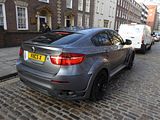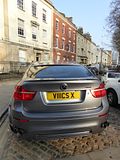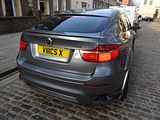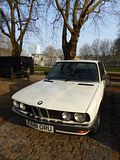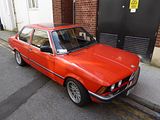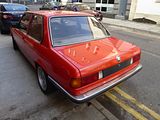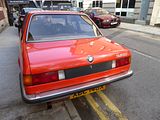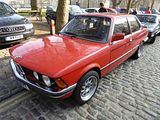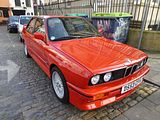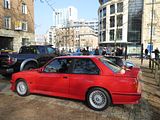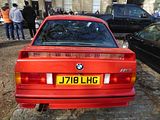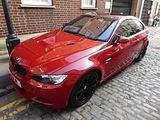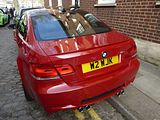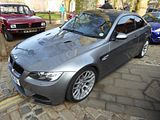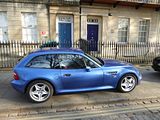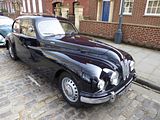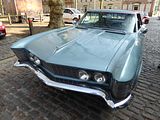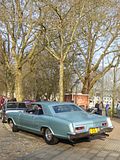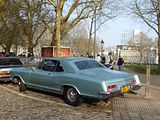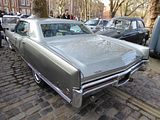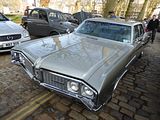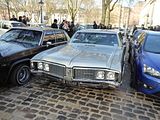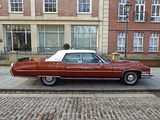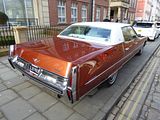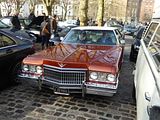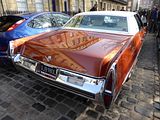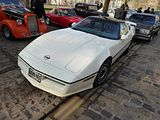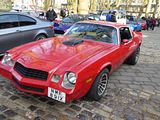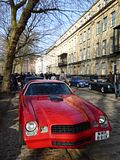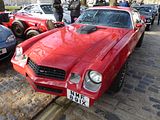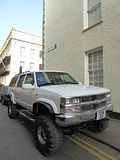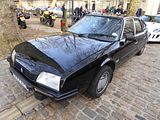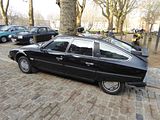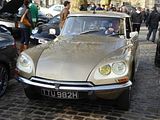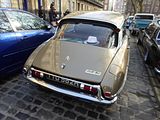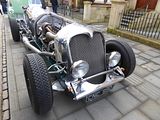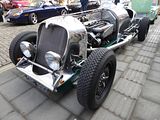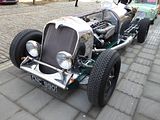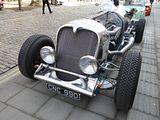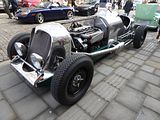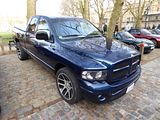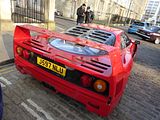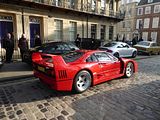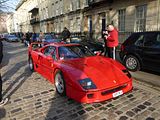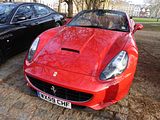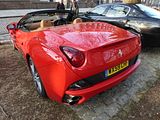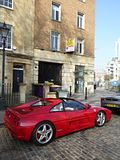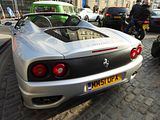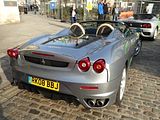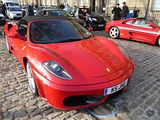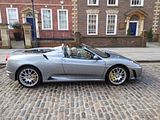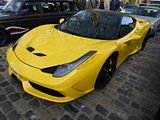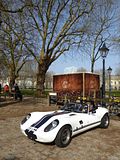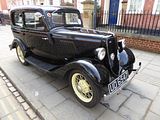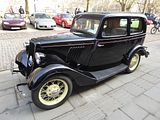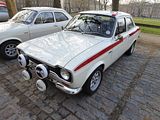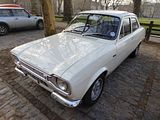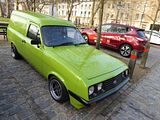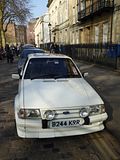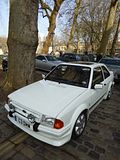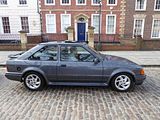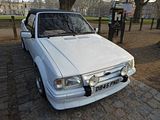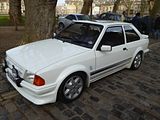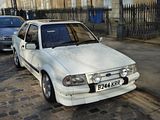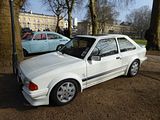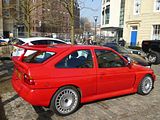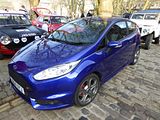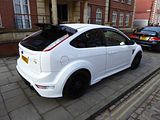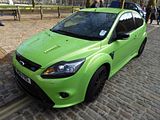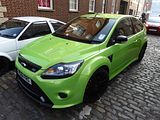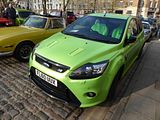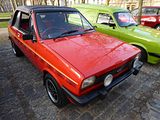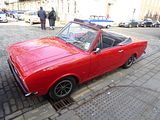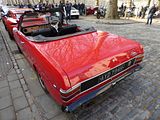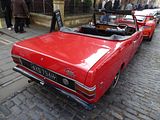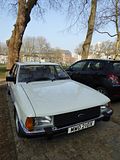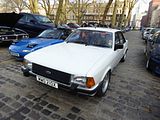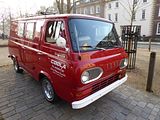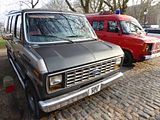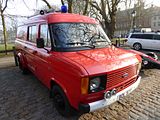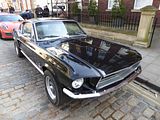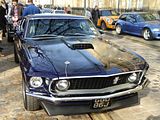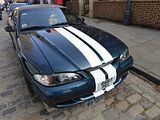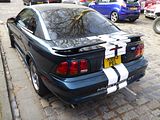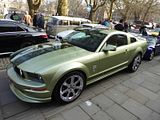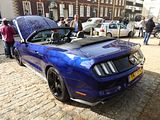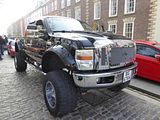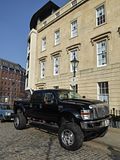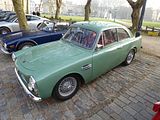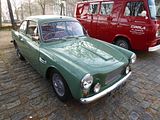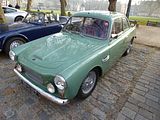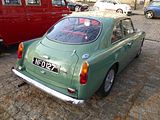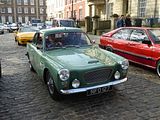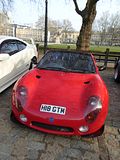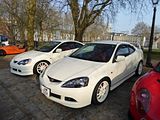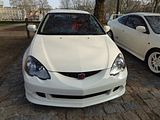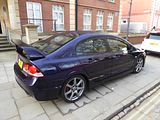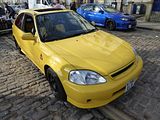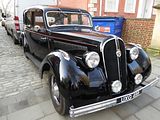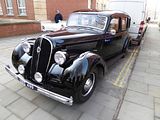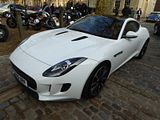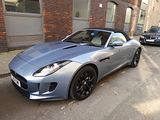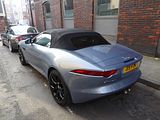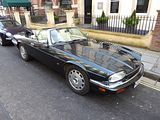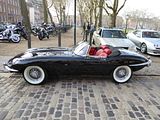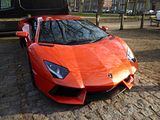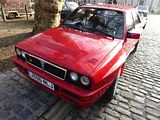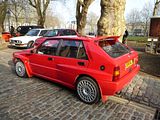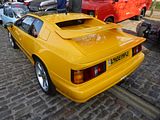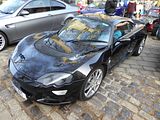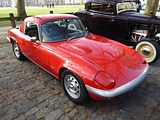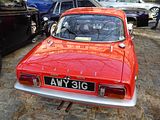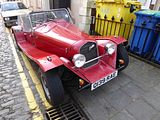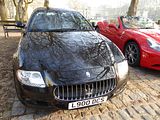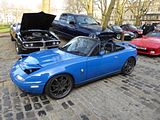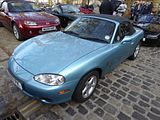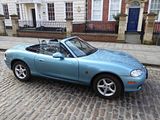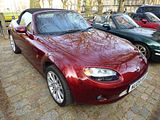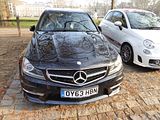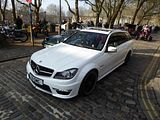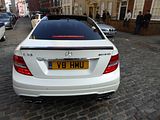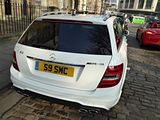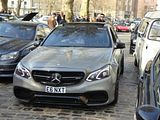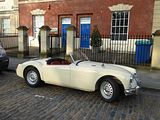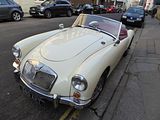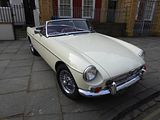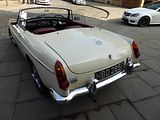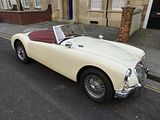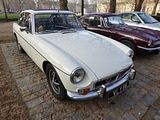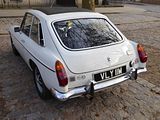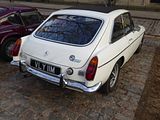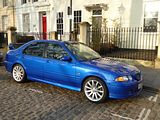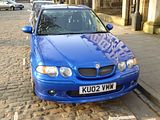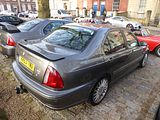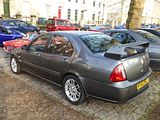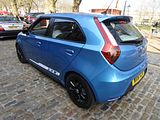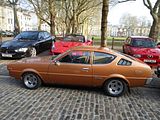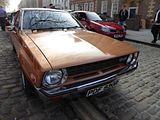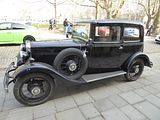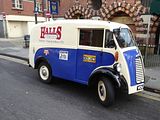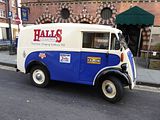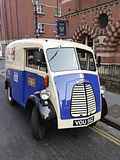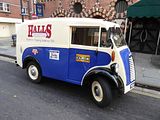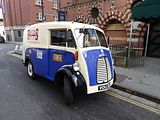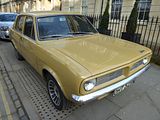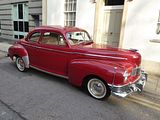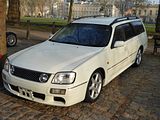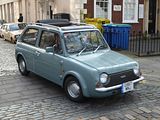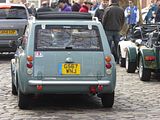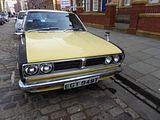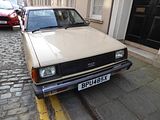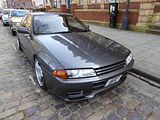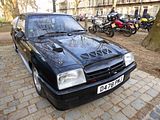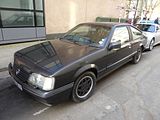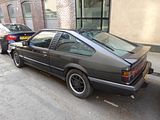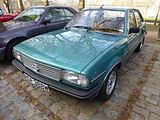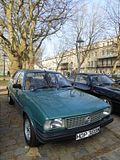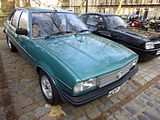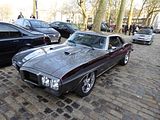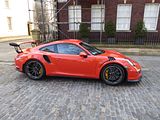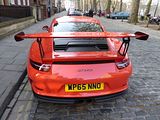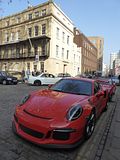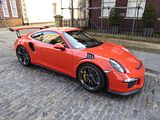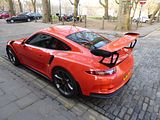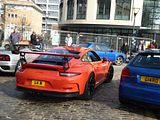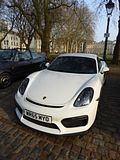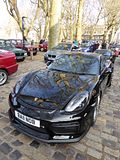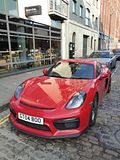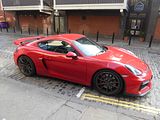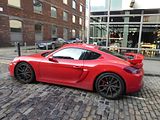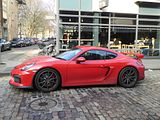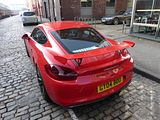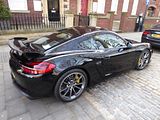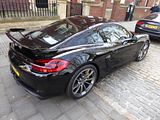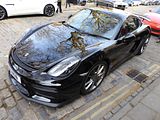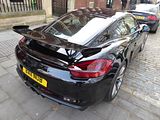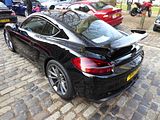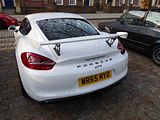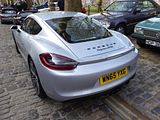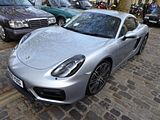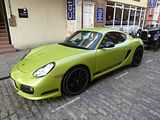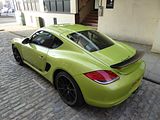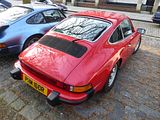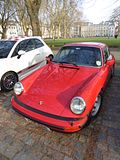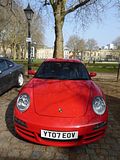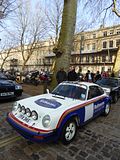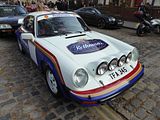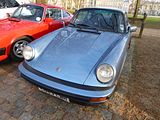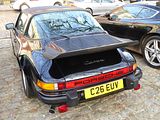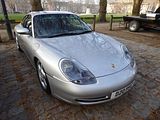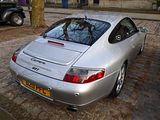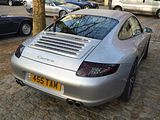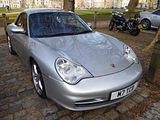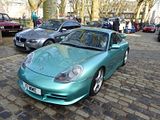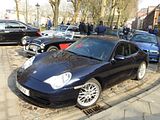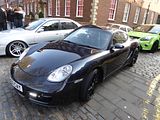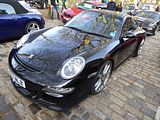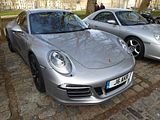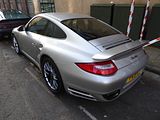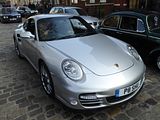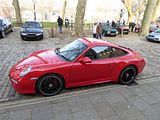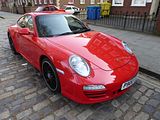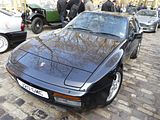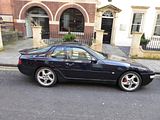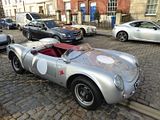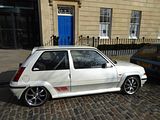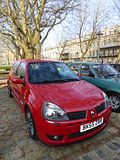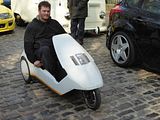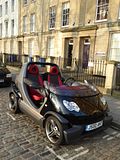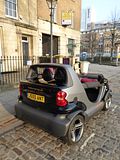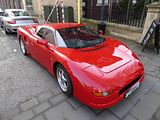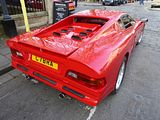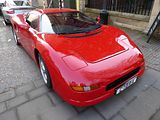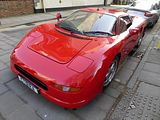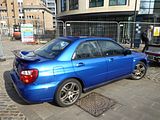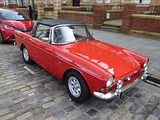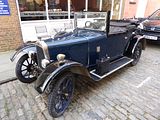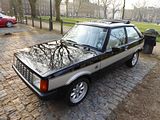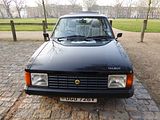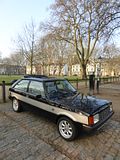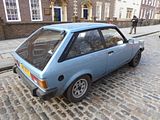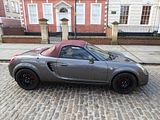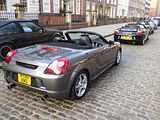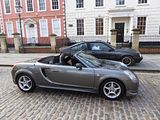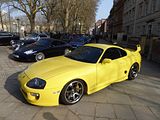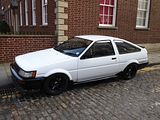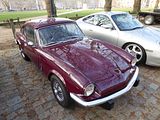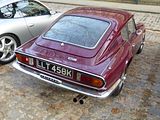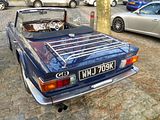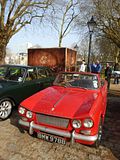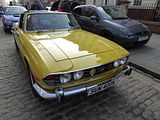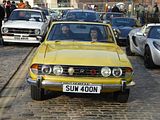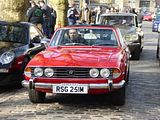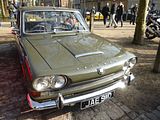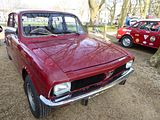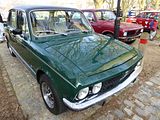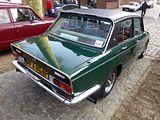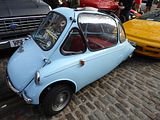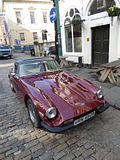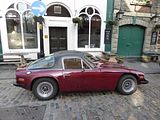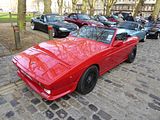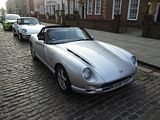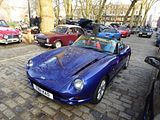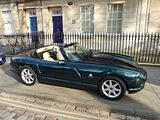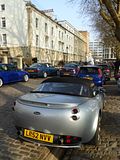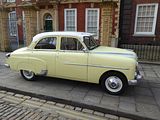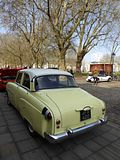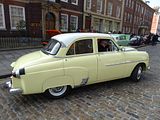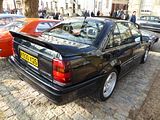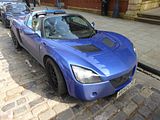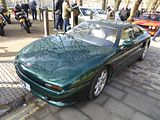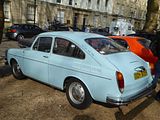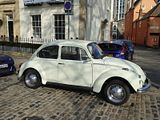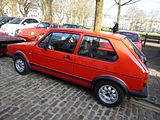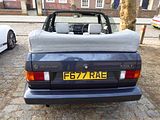That the British car enthusiast is, on the whole, a hardy individual, is beyond doubt. Despite our unpredictable weather, we buy more convertibles and open topped cars than the rest of Europe, and many is the time on a cold or damp day that you will see someone out, well wrapped up, it has to be said, enjoying roofless motoring even in the depths of winter. Even so, there is no doubt that good weather attracts even more enthusiasts either to get their own pride and joy out, or to go to an event and enjoy seeing other peoples’. So, whilst meetings like the ever popular monthly Queen Square Breakfast Club in Bristol will attract a significant number of cars even on a grotty day, when the sun shines, you can be sure of a bumper turnout. With the forecast for one of those nice and long-awaited sunny early Spring mornings to coincide with the March Breakfast Club, I guessed that the event would fill up even earlier than usual and did what I suspected lots of other would do, and set off with the clocking showing a 7 rather than an 8 in the first digit. I arrived to find my guess was correct and even though in quieter months, at 7:45, you would likely be one of the first cars to park up, this time, the inner perimeter of the Square was almost completely full. Cars kept arriving steadily and before long they were occupying every available space, and starting to park in all those places that the local traffic wardens had objected to when they came and dispensed some seasonal cheer at the December meeting. Even the side streets were rammed and yet cars continued to pour in, until the inevitable happened. A very large American Pick Up, with a need for half a county’s worth of clearance got to one of the corners and realised it could go no further, bringing the whole parade to a complete standstill for a good 20 minutes. Although the emergency services would have had a huge issue with this (I guess they could have gone the wrong way round the Square), it did help the photographers to get a lot of pictures of cars in some different places from usual. The sun probably encouraged people to stay longer, too, though when the first people did depart there were still plenty of cars ready to occupy the now vacated parking slots. Despite making several laps of the Square during my morning, I know that I still managed to miss some of the vehicles on show, which comprised the mix of Breakfast Club habituals and first timers, but even so there is still a lot to take in and this report includes around 300 photos, one of the greatest totals for such an event, Enjoy!
ABARTH
Although my 595 Competizione was the first Abarth to arrive, it was joined by others, and during the course of the morning, there were 4 Scorpion badged cars on display. All were 500-based models, with none of the less common Punto models in evidence this time. Two of them were cars I saw parked up, but did not spot with their owners present, and am indeed unsure to whom they belong, these being a 595 Turismo and an earlier example of the Competizione, whilst the fourth car, which was a relatively early 500 I did meet with its owners. He was parked near me, and I then spotted him moving the car to a newly created space on the perimeter of the Square so he could get some better photos, so we had quite a chat. He is called Chris and the car is his daily driver, which he has owned for a few months. Needless to say he loves the car. He did rather like mine, too, especially the sounds that emanate from its Monza exhaust.
AC
There tend to be a few examples of the Cobra here every month. Genuine Cobras from the first half of the 1960s are rare, and very valuable, these days, but there has been a more or less constant production of replica and continuation series cars ever since, and so there are quite a lot of cars on our roads now of the familiar Cobra shape, and all of them capable of making a lot of noise. Seen here were a couple of 427 Replica models parked up together and there was a further car around one of the other sides of the Square.
ALFA ROMEO
The pictures only show 4 Alfa Romeo models here, but I can definitively say that there were at least 5. The certain absentee is the Alfa Special belonging to David Roots, and I know it was there, because I recall having the usual catch up conversation with him that we always manage relatively early in the morning before the event gets busy, and this month he introduced me to the owner of a particularly nice Porsche which I would later find parked up around one of the other sides of the Square. David’s car was attracting lots of attention, as it always does, with crowds interested in looking at it, which is probably why there is no photo of it this month.
First of the depicted Alfa model is a 147 GTA here. The 147 made its debut in 2000 and impressed everyone with its class-leading looks and personality that ensured it claimed the Car of the Year award a few weeks later. Top of the range for some time was a 2 litre Twin Spark petrol model which went well enough, but lacked the real excitement that many were hoping for. Alfa addressed that, eventually, with the GTA model which they launched in 2002. Fitted with a 3.2 V6 engine which produced 247 bhp, it was the most powerful hot hatch available at the time, and the modifications to the body, including lower sills and wider wheel arches, if anything, made it look even better rather than endowing it with the sort of “after market look” that can afflict some high end performance versions of regular family cars. Performance figures were impressive, with the car able to achieve a top speed of 153 mph. It had a widened body by 15 mm at each side to accommodate the 225/45R17 tyres. Most models had a 6-speed manual transmissions; whilst a smaller number of other models used the semi automatic Selespeed system. Production ran through to 2004 and in total 5,029 147 GTAs were built, 1004 of which were Selespeeds. Only around 300 came to the UK, so this was never a common sighting on British roads.
It is more than 10 years since the last of the 916 series GTV and Spider cars were made, and prices have almost certainly hit the bottom, with many pundits predicting that this car will start to do what happens to almost all Alfa models, which is, it will go up in value. It would be a brave person who bet against that, as the combination of the stylish body and delightful 2 litre Twin Spark and Busso 3 and 3.2 litre V6 engines is a pretty compelling combination. There were a couple of GTV cars here this month.
Another regular attendee at the event is Nick Grange owner of two Alfas. His white 156 used to be much in evidence here, but these days he tends to bring along his older, and definitely rarer Alfa 33 Veloce instead. Whilst 156s are still reasonably common our roads, the 33 is very much a “rare breed”, but believe it or not, the 33 is actually the best selling Alfa in history, with just under a million of them sold between 1983 and 1994. Of course, precious few seem to have survived, as the car struggled to gain the affections of the enthusiasts in the way that the model’s predecessor, the AlfaSud, did, so when rust and old age came on, the vast majority of the cars were simply scrapped. There were two distinct generations of the 33. The first ran from 1983 until 1990 and then a major facelift was applied with new front and rear styling to bring the looks more into line with the new 164. A mild facelift was applied to the first 905 series cars in late 1986. Exterior alterations were limited to clear indicator lens, wheel covers and alloy wheels of new design, the adoption of side skirts on all models, and a new front grille. Two-tone paint schemes were discontinued. There were more significant changes inside, with a more conventionally designed dashboard and steering wheel, which superseded the innovative moveable instrument binnacle. All 1.5 variants now had the 105 PS engine from the now discontinued 1.5 QV; a TI (Turismo Internazionale) trim level was exclusive to the front-wheel drive 1.5 hatchback. Changes were made to the suspension, brakes and gearbox, with closer-spaced ratios. A new 1,712 cc 116 bhp engine was introduced on the 1.7 Quadrifoglio Verde, which replaced the 1.5 QV. The 1.7 engine was developed from the 1.5 by enlarging bore and stroke; it also used new cylinder heads, incorporating hydraulic tappets. To cope with the increased power the new QV was equipped with vented front brake discs. The 1.7 QV looked close to its predecessor, but had lost the grey mid-body stripe and gained new alloy wheels, wind deflectors on the front windows, more pronounced side skirts and a rear body-colour spoiler on the boot lid. Inside it featured a leather-covered steering wheel, red carpets, and leatherette-backed sport seats upholstered in a grey/black/red chequered cloth. Diesel models were offered in some continental markets, but these were not sold in the UK, where only 1.5 and 1.7 Green Cloverleaf hatchback models were sold, as well as a market-specific 1.7 Sportwagon estate; all three were also available in “Veloce” versions, outfitted by Alfa Romeo GB with a colour-matching Zender body kit. Nick’s car is one of these.
ALPINA
Even now, Alpina models are rare beasts, but go back to the 1970s and 1980s and they were almost unheard of. The first real presence that the marque had in the UK came in 1985, when an arrangement was made with Frank Sytner for distribution of them in the UK. One of the BMWs that was current at the time was the E28 5 series and there were three different Alpina models based on that car, the B7S Turbo and the B9 and B10 Saloons. The B9 came first, launching in November 1981, a few months after the debut of the standard E28, featuring a 3.5 litre inline 6 cylinder engine. When this unit was updated in 1985, the model designation changed to B10. 577 of these cars were made. In standard form, the BMW 3.5 litre engine delivered 218 bhp, but after the special Alpina treatment, this was upped to 245 bhp. Other changes included new springs, gas-filled dampers, uprated discs and 16″ Alpina wheels on the outside, and a leather steering wheel, Alpina upholstery and Recaro seats on the inside. The second generation B7 Turbo arrived in April 1984 and just like the E12 based B7S Turbo cars which had been built between November 1981 and May 1982, this was the fastest 4 door saloon in the world, and this latest one took performance to new levels. Using the BMW 3.5 litre engine again, as it now had a higher compression than before, boost was not quite as great as it had been, at 0.7 bar, but that and the other detailed changes Alpina made were enough to give the new B7 Turbo an output of 300 bhp and 320 bhp in the catalyst equipped models, along with 509 Nm of torque, resulting in a top speed of 265 – 270 km/h, and a 0- 100 km/h time of either 4.8 or 6.1 seconds depending on which test source you believe. The gearbox was a Getrag 5 speed manual unit that had been developed for the 745i. Uprated Bilstein suspension was fitted, with height adjustable rear dampers and the car had what for the time were huge wheels, 205/55 16″ at the front and 225/55 at the rear. Inside the car was much like the B7 Turbo but with a black roof lining. Alpina made 236 non cat and 42 catalyst cars before “production” ended in the summer of 1987.
ALVIS
I only caught this car as it was pulling away from the Square, so it can’t have been parked up for very long. It is a frequent attendee, so I did not need to see the badge on it, but if I had, then identifying it would not be hard, as it says quite prominently “Silver Eagle” in the grille. That’s perhaps just as well, as when it was made in the very early 1930s, Alvis still did not produce their own bodies, which means that there are all manner of different looking Alvis cars, many of which still survive. The Silver Eagle was produced from 1929 to 1936 and had a range of 6 cylinder engines from 2 to 2.3 litres in capacity.
Also an Alvis which I’ve seen here a number of types before is this Graber bodied TC108G. Just 37 of these cars were made made between 1955 and 1958. The 108G came about as coachbuilders Graber of Switzerland had produced some bodies for the existing TC21 that were much more up to date than the standard offering from Mulliners. Mulliners was increasingly coming under the control of Standard Triumph, eventually being purchased by them in 1958, and the body supply had been getting difficult. Alvis’s other main supplier was Tickford and they were bought by David Brown to use for his Aston Martin company. It was therefore decided to make the Graber style the basis of a new model and the rights were bought resulting in the TC 108G. A contract was placed with bus builder Willowbrook of Loughborough. The car was only available as a two door, four seat saloon made by forming metal around a traditional wooden frame. This proved to be expensive and the deal was terminated and a new contract placed with Park Ward, the modified vehicle becoming the better known, and mode common (it is a relative term!) TD21. The 2993 cc engine was uprated slightly to produce 104 bhp at 4000 rpm by modifying the cylinder head and fitting twin SU carburettors. Suspension was the same as the TC 21, independent at the front using coil springs with leaf springs at the rear.
ARIEL
First seen in public at the British International Motor Show at the NEC in Birmingham in October 1996, the Atom began as a student project by Coventry University transport design student, Niki Smart. Known then as the LSC (Lightweight Sports Car), it was developed at the university in 1996 with input and funding from various automotive industry members, including British Steel and TWR. Ariel Motor Company boss Simon Saunders was a senior lecturer whose responsibility for the project was primarily as financial manager and design critic for Smart, whom he described as “The best all-round design student I’ve ever seen.” Since then, an operation was created in Crewkerne, Somerset, and around 100 cars a year are produced there. Each one is made by a single person, who undertakes everything from assembly to final road test before putting his name on the finished product. There have been 7 distinct models, with a wide variety of different engines ranging from a 2 litre Honda VTEC unit in naturally aspirate and supercharged guise, to the ultimate, the 500, with a 3 litre V8 that generates 500 bhp. Visually, the cars look similar at a quick glance, and it takes a real marque expert (which I am not!), to tell them apart. Never intended as an every day car, as their real raison d’etre is as a track machine, owners do take them out on public roads, and in traffic, from time to time. so, given the fact that the journey here would have been a sunny start on largely empty roads, perhaps it was not a surprise to find one parked up here.
ASTON MARTIN
Three Aston Martins were here, a DB9 and a first generation Vanquish were parked up on the Square whereas this DB7 had had to be left on one of the adjoining side streets. This car had been modified, with new detailing features which, well, would not appeal to everyone.
AUDI
A few months after presenting the ground-breaking Quattro, Audi revealed a cheaper model which used the same bodyshell, but without the all wheel drive system and sporting the regular 5 cylinder 2.1 litre engine devoid of turbo under the bonnet. It was simply called Coupe. Commercially, of course, it was far more significant than the Quattro, as this was not just a successor to Audi’s own 100 Coupe, production of which had ceased a few years earlier, but was a more modern rival to cars such as the venerable Ford Capri, Opel Manta and Alfetta GTV. More powerful models were added to the range over time, and in 1985 Audi facelifted the car, and added the option of the quattro system so creating the Coupe quattro that occasionally even gets buyers excited about how cheaply they think they could acquire a Quattro. It is largely because the Quattro remains an icon, and the Coupe has all but disappeared, I guess, that this mix-up can arise. I had not seen an early Coupe such as this one for quite a while, and got quite excited. And then I saw what the owner had done to the wheels……….
A couple of months ago, there was a long line up of first generation TT models present, but this time there was just the one Coupe.
There were two of the latest RS3 models here, and both did a number of laps of the Square, looking for somewhere to park. Confusingly, both were painted in the same shade of grey, and it took a while before I realised from some of the other details that there were in fact two different cars.
The other RS Audi to be captured was this B5 generation RS4 Avant. This dates from an era when Audi only produced one RS model at a time, meaning that the variant had quite a short production life. Introduced by Audi in late 1999, for main production and sale from 2000, this was effectively the successor to the Porsche / quattro GmbH joint venture-developed Audi RS2 Avant that was sold in the mid 1990s. Like its RS2 predecessor, it was available only as an Avant. Although related to the Audi B5 S4, many of the outer body panels were altered, with wider front and rear wheel arches, to allow for the wider axle track on the RS 4. With unique front and rear bumpers and side sills, and the rear spoiler from the S4 Avant, the aerodynamic modifications achieved a drag coefficient of Cd 0.34 and a very purposeful look, especially when finished in a sober colour such as the two examples seen here. It was the mechanical changes, though, which had the huge difference. The engine was developed from the 2.7 litre V6 ‘biturbo’ used in the B5 S4, and retained the same 2,671 cc capacity, but much was changed. Developed and manufactured in the UK by Cosworth Technology, it featured enlarged intake and smaller exhaust ports on the two Cosworth cast aluminium alloy cylinder heads, two parallel BorgWarner turbochargers, two larger side-mounted intercoolers, dished piston crowns, stronger connecting rods, larger intake ducting, enlarged exhaust system, and a re-calibrated engine management system. The modifications increased the engine’s output from 265 bhp to 375 bhp at 7,000 rpm, and with 325 lb/f·ft of torque. The engine was controlled by a Bosch Motronic ME 7.1 electronic engine control unit (ECU), using a Bosch ‘E-Gas’ electronic drive by wire throttle. The engine had multipoint sequential fuel injection, a MAF, six individual single-spark coils and NGK longlife spark plugs. The engine oil was cooled by a dual oil:water cooler and an oil:air cooler. There was a 6 speed manual transmission and Audi’s Torsen-based quattro system. Even with a kerb weight of 1,620 kilograms (3,571 lb), the RS 4’s powerful engine gave it the performance of a sports car. 100 km/hcould be reached from rest in 4.9 seconds, 160 km/hin 11.3 seconds, and 200 km/h in 17.0 seconds. Top speed was electronically limited to 262 km/h (162.8 mph) Audi produced 6,030 units between 1999 and 2001.
AUSTIN HEALEY
3000
BMW
A car I’ve not seen here before, and noting its “For Sales” signs in the window may well not see again was this Hamann-modified X6. I will not comment further for fear of upsetting those who actually approve both of the Hamann modifications and even the car on which they were based…….
Far more to my taste were the other BMWs that my camera recorded. A couple of these were from the era when BMWs were far less common than they are now, back in the early 1980s, with an E28 5 Series and an E21 320 both parked up. BMWs of this era were sold very much as the “Driving Machine” where the emphasis was on what they were like to drive, rather than luxury fittings, so most models of this era, unless the owner raided the options list were pretty basic. Radios were not standard until well into the 1980s, for instance. The rear suspension especially of the 3 series of the day also came in for criticism, with the resultant handling being castigated as having nasty traces of snap oversteer – precisely what the boy-racer road testers of our current generation expect and will moan if a car does not do this. How times change!
There were two pairings of M3 models on show, with a couple of the first of the breed, the E30 and a couple of the recently superceded E92 cars.
Z model BMWs were represented by this Z4 Coupe 3.0 Si, as well as the earlier Z3 seen in both open-topped and the exclusive (and expensive when new) Coupe.
BRISTOL
This 403 is an example of the second body design produced by Bristol Cars. First seen on the 401 model, which replaced the first ever Bristol model, the 400, a program of updates saw the car morph into the 403 (the 402 having been an open topped version of the 401) and this car was then produced between 1953 and 1955, the third of the eventual five series of Bristols powered by the BMW-derived pushrod straight-six engine. It replaced both the Bristol 401 and 402 in 1953 and whilst it retained much the same styling as the 401, the new 403 featured many mechanical improvements compared to its predecessor. The 1971 cc six-cylinder engine was modified through the use of bigger valves and larger main bearings with a diameter of 54 mm as against 51 mm on the 400 and 401, which increased the power output to 100 hp as against 85 hp in the 401. The acceleration was markedly improved: the 403 could reach 60 mph in 13.4 seconds as against 16.4 seconds for the 401. The 403 had a top speed of 104 mph. To cope with this increased power, an anti-roll bar was fitted on the front suspension and improved drum brakes known as “Alfins” (Aluminium finned) were fitted. Early models had them on all wheels, but Bristol thought the car was over-braked and they were thus restricted to the front wheels on later 403s. The 403 was the last Bristol to feature a BMW-style radiator grille. It is also noteworthy for having two extra headlamps at the side, almost pre-dating the adoption of the four-headlamp layout in larger cars (Bristol themselves adopted it with the 411 in the late 1960s).
BUICK
There nearly seems to be a nicely presented American classic at this event which has not been seen before, and this month it was a lovely Buick Riviera which fulfilled that brief. Launched in 1963, the origins of the car are more complex than you might think. In the late 1950s, GM lacked a personal luxury car to compete with the highly successful Ford Thunderbird—a uniquely styled, two-door, four-passenger car. To fill this gap, an experimental Cadillac design, the XP-715, was created. Its angular styling was reportedly inspired by GM styling chief Bill Mitchell’s visit to London during the period, when he was struck by the sight of an elegant, custom-bodied Rolls Royce. He later said that “knife-edged” styling was what he wanted for the new model, but with a lower profile. The design itself was penned by stylist Ned Nickles. However, Cadillac management was not particularly interested in such a vehicle and in 1960 the project was thrown open for competition by the other GM divisions. Buick, desperate to revive its flagging sales, enlisted the aid of the McCann-Erickson advertising agency to create its presentation. Buick won, and the finished design was adapted to a shortened version of Buick’s cruciform frame. The design was substantially the same as the original, although the hidden headlights—originally concealed in the fender grilles—were initially omitted for cost reasons. The production Riviera’s distinctive bodyshell was unique to it, which was unusual for a GM product. It rode a cruciform frame similar to the standard Buick frame, but shorter and narrower, with a 2.0 in narrower track. Its wheelbase of 117 in and overall length of 208 in were 6.0 inches and 7.7 in shorter, respectively, than a Buick LeSabre, but slightly longer than a contemporary Thunderbird. At 3,998 lb it was about 390 pounds lighter than either. It shared the standard Buick V8 engines, with a displacement of either 401 cu in (6.57 litres) or 425 cu in (6.96 litres), and had a unique continuously variable design twin turbine automatic transmission. Power brakes were standard, using Buick’s massive “Al-Fin” (aluminium finned) drums of 12 in diameter. Power steering was standard equipment, with an overall steering ratio of 20.5:1, giving 3.5 turns lock-to-lock. Rather than the “Sweepspear” used on beltlines of earlier Buicks with the Riviera package, the new Rivera sported new “Coke bottle styling”, with the middle of the body exhibiting a tapered tucked-in appearance. The Riviera was introduced on October 4, 1962, as a 1963 model, with the 325 hp 401 cu in (6.6 l) “Nailhead” V-8 as the only available engine, fitted with dual exhaust as standard equipment, and the turbine drive the only transmission, at a base price of $4,333, though typical delivered prices with options ran upwards of $5,000. Buick announced in December 1962, the availability of a 340 hp 425 cu in (7.0 litre version of the Nailhead as an option. Total production was deliberately limited to 40,000 vehicles (in a year that Buick sold 440,000 units overall) to emphasise its exclusivity and to increase demand; only 2,601 of them were delivered with the 425 cu in engine in the 1963 model year. The Riviera continued with minimal trim changes for 1964. For 1965, Buick introduced the “Gran Sport” option, which included the dual-quad Super Wildcat 425 V8, a numerically higher 3.42 axle ratio, and stiffer, heavy-duty suspension. The stock dual exhaust pipes were increased from 2.0 inches to 2.25 inches inside diameter and had fewer turns to reduce backpressure. The 401 cu in V8 returned as the standard Riviera engine and the Super Turbine 400 transmission retained the variable pitch torque converter, but was fitted with a three-speed gear selector. Externally, the headlamps were concealed behind clamshell doors in the leading edges of each fender, as in the original design. Further back, the non-functional side scoops between the doors and rear wheel arches were removed, and the taillights were moved from the body into the rear bumper. A vinyl roof became available as an option, initially offered only in black, and the tilt steering wheel optional in previous years was now standard equipment. A second generation model, based on the first was announced for the 1966 model year. This and all subsequent models, although still well liked would never quite hit the same spot as the first Riviera. Total sales for the three model years was a respectable 112,244. All in all, the Riviera was extremely well received and considered a great success, giving the Thunderbird its first real competition. These days the car is considered highly collectible.
Buick first used the name Electra in 1959, and it was continuously applied to the top models in the range right through to 1990. Classical scholars may think that the name came from Greek mythology, but in fact, it was the name of the President of General Motors’ sister-in-law, Electra Waggoner Biggs. Seen here is an Electra 225 from 1969. That model year saw a major restyling to the car and indeed the other GM B-body and C-body cars with somewhat crisper bodylines than the 1965–68 models, even though these new cars continued with the same chassis and inner body structure that had been introduced with the 1965 model. This was an era of huge cars, so the wheelbase was increased one inch to 127-inch. Just how big it is was proven when the owner tried to thread his car between the lines of parked cars around one side of the Square. It did fit, but it was extremely tight and required people on either side to check that he had enough clearance to edge his way forwards.
CADILLAC
Bigger even than the Electra was this 1973 Cadillac Sedan deVille. I did talk to the owner, as he wanted to depart, and reassuring him that the Electra had threaded its way between the cars was all he needed to hear before he set off, though not before I grabbed a few photos of his car. This generation of full-sized Cadillac, produced between 1971 and 1976, was the apogee of the massive full-sizer, before the down-sizing trend started. With 64.3 inches front shoulder room (62.1 inches on Cadillac) and 63.4 inches rear shoulder room (64.0 inches on Cadillac) the new for 1971 full-sized GM cars set a record for interior width that would not be matched by any car until the full-size GM rear-wheel-drive models of the early to mid-1990s. The styling of the new Cadillacs bore a strong resemblance to the models they replaced, but there were differences. Pairs of individually housed squarish headlamps were set wider apart. The V-shaped grille had an eggcrate style insert and was protected by massive vertical guards framing a rectangular license plate indentation. A wide bonnet with full-length windsplints, a prominent centre crease and hidden windshield wipers was seen. A Cadillac crest decorated the nose and new indicator lamps appeared atop each front fender. A horizontal beltline moulding ran from behind the front wheel housing, almost to the rear stopping where an elliptical bulge in the body came to a point and where thin rectangular side markers were placed above and below the chrome strip. The rear wheel openings were again housed in fender skirts. Tail lamps were of the same type as before but were no longer divided by a chrome bar. Long horizontal back-up lamps were set in the bumper, on either side of a deeply recessed license plate housing. De Villes were set apart visually by thin bright metal rocker panel steps and signature script on the front fenders bearing the series name. The bottoms of the rear fenders were decorated with a bright metal beauty panel that was wider than the rocker panel strips and blended into the moulding running along the bottom of the fender skirt. The standard engine remained the 472, still rated at 375 SAE gross hp and 365 lb/ft of torque. Detailed styling changes were made every year throughout the 5 year production run, with energy absorbing bumpers appearing in 1973, a year in which sales set a new record at 216,243. 1974 saw the introduction of the optional “Air Cushion Restraint System”. Known today as airbags, this option provided protection for front seat occupants in the case of a frontal collision. One bag was located in the steering wheel, the other in the dashboard in front of the front seat passenger. The glove box was replaced with a lockable storage compartment under the dashboard. The option was unpopular and was discontinued after the 1976 model year.
CATERHAM
Caterham drivers bring their cars to this event even when the weather is at its least agreeable, so by comparison, a day like this one would have seemed like a particularly good one to enjoy the thrills of driving a Seven, so the surprise is not that there was an example here but that there were not more.
CHEVROLET
Although you’ve been able to order a brand new Corvette in the UK, off and on, for many years, from a couple of specialist GM dealers, few people have, and yet there are a surprising number of Corvettes of each of the 7 distinct generations that have been produced over the past 63 years, in the UK, so it is not really a surprise to see one, or more, at an event like this. There was only one present here, a C4. This is the generation that was launched in 1983, as a 1984 model year car, and was the first complete redesign of the car for 20 years. Having toyed with the idea of a mid-engined model in the mid 70s, GM ended up keeping the same formula of a large boldly styled front engined rear wheel drive model with a potent V8 up front. Open topped and more powerful versions would be added to the range during the C4’s life, as GM recovered from the era of the emissions-strangled engines of the late 70s and early 80s.
The Camaro was GM’s very definite response to the huge success of Ford’s Mustang, which had been codenamed Panther. Although there had been rumours that GM was doing something, this was an era when even the journalists were surprised. and on June 21, 1966, around 200 automotive journalists of them were when they received a telegram from General Motors stating, “…please save noon of June 28 for important SEPAW meeting. Hope you can be on hand to help scratch a cat. Details will follow…(signed) John L. Cutter – Chevrolet public relations – SEPAW secretary.” The following day, the same journalists received another General Motors telegram stating, “Society for the Eradication of Panthers from the Automotive World will hold first and last meeting on June 28…(signed) John L. Cutter – Chevrolet public relations SEPAW secretary.” These telegrams were something of a puzzle at the time. On June 28, 1966, General Motors held a live press conference in Detroit’s Statler-Hilton Hotel. It was to be the first time in history that 14 cities were connected in real time for a press conference via telephone lines. Chevrolet general manager Pete Estes started the news conference stating that all attendees of the conference were charter members of the Society for the Elimination of Panthers from the Automotive World and that this would be the first and last meeting of SEPAW. Estes then announced a new car line, project designation XP-836, with a name that Chevrolet chose in keeping with other car names beginning with the letter C such as the Corvair, Chevelle, Chevy II, and Corvette. He claimed the name, suggests the comradeship of good friends as a personal car should be to its owner and that to us, the name means just what we think the car will do… go. The Camaro name was then unveiled. Automotive press asked Chevrolet product managers, what is a Camaro? and were told it was a small, vicious animal that eats Mustangs. According to the book “The Complete Book of Camaro: Every Model Since 1967”, the name Camaro was conceived by Chevrolet merchandising manager Bob Lund and General Motors vice president Ed Rollett, while they were reading the book Heath’s French and English Dictionary by James Boïelle and by de V. Payen-Payne printed in 1936. Lund and Rollett found the word “camaro” in the French-English dictionary to mean friend, pal, or comrade. The article further repeated Estes’s statement of what the word camaro was meant to imply, that the car’s name “suggests the comradeship of good friends, as a personal car should be to its owner”. In fact, the actual French word that has that meaning is “camarade”, from which the English word “comrade” is derived, and not “camaro”. “Camaro” is not a recognised word in the French language. Be that as it may, the Camaro was first shown at a press preview in Detroit, Michigan, on September 12, 1966, and then later in Los Angeles, California, on September 19, 1966. Public introduction of the new model was on September 26, 1966. The Camaro officially went on sale in dealerships on September 29, 1966, for the 1967 model year It was an instant success. The first generation model ran for three years before an all new second generation car premiered (late) for the 1970 model year. Dubbed “Super Hugger”, the second-generation Camaro was developed without the rush of the first generation and benefitted from a greater budget justified by the success of the first generation. Although it was an all-new car, the basic mechanical layout of the new Camaro was familiar, engineered much like its predecessor with a unibody structure utilising a front subframe, A-arm and coil spring front suspension, and rear leaf springs. The chassis and suspension of the second generation were greatly refined in both performance and comfort; base models offered significant advances in sound-proofing, ride isolation, and road-holding. Extensive experience Chevrolet engineers had gained racing the first-generation led directly to advances in second-generation Camaro steering, braking, and balance. Although it began its run with a number of high-performance configurations, as the 1970s progressed, the Camaro grew less powerful, succumbing, like many production cars of the era, to the pressures of tightening emissions regulations and a fuel crisis. Major styling changes were made in 1974 and 1978; 1981 was the final model year for the second-generation Camaro and it was one of the 1981 cars which was to be seen here..
The third Chevrolet here was very different, a Blazer that was raised up so that getting in and out of it would present someone like me with a very real challenge!
CITROEN
There were two Citroen models here, both of which have been at the event before. Newer of the pair was a fabulous CX25 GTi Turbo. Citroen created a higher-powered more sporting CX with the 128 bhp fuel injected GTi in 1977, but in 1984, a more potent true of the top of the range joined it, adopting the then very popular expedient of strapping a turbocharger to the 2500cc engine which upped the power to 168 bhp. A larger rear spoiler was fitted to aid high speed stability.
Nice though the CX is, it was the other Citroen which I would choose if asked to opt between the two, This is a DS21 EFi, which has the final iteration of the iconic styling, complete with headlamps that swivel when you turn the steering wheel, but lacking the more potent 2.3 litre engine which went into the top of the range models over the 70s. Nicely presented examples of the DS are still rocketing in value, and when you look at this car, it is not hard to see why.
CUMMINS-RAILTON
No question about it, this was “the” car of the morning, with large crowds all around it almost permanently, so it was only late on that I was able to get a close look myself and get my own photos and find out a little about what it was, which is always useful in providing clues on how to start off with Google after the event. Those familiar with the record-breaking Napier Railton, which lives in the museum at Brooklands, but which makes fairly frequent outings to circuits and hill climbs during the course of a year will spot the physical resemblance, but when the owner said that it was powered by a Cummins diesel engine, I did wonder about that choice. What my researches unearthed, though is that a record breaking car, powered by a Cummins diesel engine was produced slightly before the Napier. The Napier-Railton is powered by a Napier Lion XI gasoline 12-cylinder aero engine, with 24litres and a rated power of 395kW. It was first raced in August 1933 by John Cobb and broke the Brooklands outer circuit lap record of 143.4mph in 1935 and then went on to set the 24-hour record of 150.6mph at the Bonneville Salt Flats, USA, in 1936. Cummins has a strong history in racing, using it to test product durability as far back as the early 1930s. The 1931 Cummins Diesel Special No. 8 Indianapolis 500 car still runs, and is displayed in the Indianapolis Motor Speedway Museum. The Cummins Diesel No.8 became the first diesel vehicle to reach 100 mph, running on the hard sand at Daytona Beach, Florida. Power came from a race modified Cummins Model U 4-cylinder, 6-litre diesel with 85 hp, the most powerful diesel engine in the world at the time. So, selecting a modern Cummins Diesel is not quite as strange as you might think. In the Cummins-Railton, dimensionally identical to the Napier, power comes from a modern Cummins 6.7 litre diesel, the same base engine widely used in many types of construction equipment, including excavators and wheeled loaders. While the latest ISB6.7 engine meeting Tier 4 Final/Stage IV emissions regulations offers an impressive top rating of 300 hp, Cummins engineers managed to achieve close to 500 hp for the 6.7-litre diesel installed in this replica, which was created by British engineer Terry Clarke, working closely with engineers located at the Cummins Darlington engine plant. It was produced around 5 years ago, making its debut at the 2011 Goodwood Festival of Speed.
DODGE
Ram 1500 Pickup
FERRARI
A rare visitor to this event was this F40, which arrived relatively early, and was only parked up for an hour or so, before taking off again. Needless to say, this was a star attraction for many and there were crowds surrounding it most of the morning.
Other Ferraris present, nice though they all were, seemed that bit tame, by comparison. Most of them were open topped cars with a California, an F355 Targa, a 360 Spider and a couple of F430 Spiders among them, as well as 458 Italia.
FISHER
This is one of those cars which has appeared sufficiently frequently at the event that I know now what it is. Known as a Fury or Fisher Fury, it is a kit car, as you would perhaps guess, and like many, the history of this model turns out to be somewhat complex. The car seen here looks like a Stylus RT. Launched in 1994, by Sylva Autokits, the first Styluses used a modified Fury chassis, but later a purpose built chassis was made to accommodate the lowered doors. The Fury had been launched by Sylva Autokits in 1991 and then sold on to Fisher Sportscars in 1994, and currently owned by Fury Sportscars who recently purchased the rights from BGH Geartech, based in Kent UK. The Fury has been very successful in competition with cars currently racing in many championships, including the 750 Motor Club’s RGB (Road-Going Bike-Engined Kitcar) and Kitcar series. Many different engines can be fitted to the Fury, including all manner of car engines from the Ford Crossflow to Rover V8 and Cosworth Turbo. Motorbike engines have also been fitted and are popular for track cars due to the low weight, high power and built-in sequential gearbox for relatively little money. There are two versions of the Fury rear suspension: the Live Axle version uses the Ford Escort rear axle located using two trailing links in conjunction with a Panhard rod. Coil over shock absorbers are used to give good ride comfort combined with excellent handling and grip; the Independent Rear Suspension version uses the Ford Sierra rear hub assembly in conjunction with purpose built hub carriers forming the uprights between upper and lower wishbones. Once again, coil over shock absorbers ensure a refined ride quality and excellent traction. For the new Stylus, the front rocker arms were upgraded with needle bearings and the front lower arms got redesigned to prevent the lower ball joints being damaged. As with most Sylva models, various engines could be fitted. The design was updated in 2003, with the Stylus RT which made a more modern looking sportscar. The Stylus RT (Road & Track) used the SSC standard chassis, but with wider front suspension, and uses wheel spacers at the rear. The rear wing was developed at Swansea University in their motorsport department. The RT also has a full front splitter and a rear diffuser. These 3 aerodynamic aids are optional extras. SSC fitted quad style lights. A standard Stylus can be modified to RT specification. The design rights of the Stylus were sold to Specialist Sports Cars in 1996, who sold them on to Stylus Sports Cars in 2004 but this company went bust in 2008.
FORD
Ford is nearly always one of the best represented marques, with strong representation of both the many performance cars in the Blue Oval’s history as well as some more “ordinary” cars, most of which were once a common sight on our roads, but which time has thinned out to make them quite rare. Oldest of those on display this time was an event regular, this diminutive Model Y. Sometimes called the Eight, the Model Y was the first Ford designed in Europe. It was powered by a 933 cc, 8 hp Ford sidevalve engine, and was available in two and four-door versions. The suspension was by the traditional Ford transverse leaf springs front and rear and the engine drove the rear wheels through a three-speed gearbox which, right from the start, featured synchromesh between the top two ratios. The maximum speed was just under 60 mph and fuel consumption was 32 mpg. Even by the standards of the time, the car, like its major competitor the Austin 7, was found noteworthy for its almost unbelievable lack of brakes. In June 1935 a reduced specification two-door model was the only closed-body car ever to sell in Britain for just £100, a price it held until July 1937.
Most of the other European Fords here were sporting models, and whilst there were fewer than you sometimes get in attendance, there was still plenty of variety. Most numerous were those bearing Escort badges, with the Mark 1 represented by a Mexico and a Twin Cam, the Mark 2 by a van which had received the distinctive RS2000 front end grafted on to it, the Mark 3, first of the front drivers by an XR3i a Cabrio and a couple of the RS Turbo cars and the final, and fourth generation to bear the name, by the RS Cosworth.
More recent sporting Ford models present included a couple of the much praised Fiesta ST, and several second generation Focus models in both ST and RS guise.
Many of the Fords to be seen here are regulars, and one such is this Fiesta Fly, a conversion of Ford’s first ever front wheel drive supermini which was first seen in 1981. Designed by David McMullan, it had a permanently welded-shut boot, with a plastic sill fitted to prevent the car from needing to be repainted. The production history of the Fiesta Fly is not clear; but the common claim that only 20 or so cars were built is probably untrue. It is believed that this figure refers to the number built by Crayford, rather than the number built in total. What is known is that Dorset-based firm F. English Coachwork Division bought the rights to produce the Fiesta Fly sometime in 1982, and Autocar reported in September 1983 that about 100 Fiesta Fly conversions had been produced. It is believed that F English built around 200 Fiesta Flys, with 83 known to survive. Crayford also reportedly built two Fiesta Flys based on the Mk2 Fiesta. It was possible to purchase any production Fiesta model in Fiesta Fly form, not just the 1300 and XR2 models as is often reported.
It was not the only open topped Ford, as another Breakfast Club regular was also here, evidence of the fact that specialists filled the gap in Ford’s product range throughout the 60s, 70s and early 80s, by removing the roof of some of the Blue Oval’s products and finding small numbers of buyers. Crayford actually produced convertible versions of every generation of Cortina, but none of them were exactly volume sellers as the problem was cost. Around 50 conversions of the Mark 1 Cortina had been completed in 1965 and early 1966 when Ford told Crayford there would be an “all new” Cortina for the October 1966 Motor Show. Crayford did not want to wait up to a year to develop a Mk.2 Cortina Crayford, so they asked Ford if they could supply a car there and then for development work, but they were told that no pre production cars where available and, in any case, the car was top secret until press day at the Motor Show. They did however agree to ship, in great secrecy, a Mk.2 two-door shell and all the parts in kit form. Crayford’s directors and staff then began building the car at the Westerham factory and with only two weeks to go, Director Jeff Smith set about converting the car into a Crayford convertible, virtually single-handed, working night and day on the project. The result was, that when the show opened on press day, the Ford Motor Company had on their stand No.143, an entire range of six, all new, Cortina saloons and GT’s, but not far away on stand No.173, surrounded by a bevy of trendy dolly girls dressed in black and white chequered mini dresses, was a shiny metallic blue mink Crayford Cortina Mk.2 with a white pvc hood. This car still exists has been in the long term ownership of the Crayford Car Club magazine publisher John Peters and is registered SOO 661D, it still has many unique pre production features. Crayford followed up a year later at the Earls Court Motor Show with an upmarket and expensive Mk.2 Cortina Cabriolet, this had a smaller hood that sat deeper into the car around a much smaller rear seat, suitable only for children, in effect it made the normal 5 seater convertible into a two plus two car. The car even had an inner headlining for extra comfort. Being a shorter hood it was capable of one-man-operation and the car also had a longer metal rear deck than the 5 seater convertible. Crayford soon had a full order book and made two, sometimes three a week with a total production run of over 400 convertibles and a handful of cabriolets, which like all Crayford cabriolets had to be built in Cologne, Germany under licence. Crayford further developed their Mk.2 Cortina with a tiny number of two door pillarless hardtops. These looked very much like the then current Lancia Flavia coupe with an all glass top profile and very slim roof pillars, back and front. It was rumoured to have two Cortina windscreens, one for the front and one for the back, but this is not true. It may be that only five were built on GT base cars and one was even a Lotus Cortina based. A further development were the Crayford Mk.2 saloons, with big engine conversions that took the legendary Jeff Uren 3 litre Savage Cortina head-on. One yellow car was delivered new in both options, ie it was a 3litre V6 engined convertible. The roofless chassis wasn’t really up to the job. Most desirable are the 40-plus Lotus Cortina Crayford convertibles, mainly standard green and white, with one, a special order built at Lotus, in black – the owner did not want a resprayed car converted. Today around 126 open-topped Cortina Mark 2s survive on the club register, though as is often the case, there are some fake cars out there as well.
Two Fords from the late 70s were the Capri 2.8i and a Granada Mark 2, both popular cars in their day as they exemplified Ford’s tradition of providing good levels of performance at an affordable price, with all the ease of ownership attributes that applied to every model in the range.
This beautifully presented E-Series Econoline Van has been at every one of the recent Breakfast Clubs that I have attended. An example of the first series to bear the name, the first Ford Econoline was introduced for the 1961 model year. Based on the compact Ford Falcon, it was sized roughly to compete with the Chevrolet Corvair 95 (Greenbrier Sportswagon) and Volkswagen Type 2, which was 172.3 in (4,376 mm) long. It was originally offered as a cargo van, an eight-passenger van with three rows of seats (which carried the Ford Falcon name) and as a pickup truck. A 165 lb (75 kg) counterweight was fitted over the rear wheels to balance the front-heavy vehicle, which was sometimes removed by later owners. The implementation of situating the driver on top of the front axle with the engine near the front wheels is called, in the US, a “cab over” short for cab over engine configuration. In Europe it is called a “forward control” vehicle. The body styling borrowed heavily from the, smaller, UK produced, Thames 400E which had been in production since 1957 and the 1956-64 Jeep Forward Control. Instead of the rear-mounted engine used by Volkswagen and Chevrolet, the first E-Series had a flat nose with the engine between and behind the front seats. Early models had a 144 CID inline 6-cylinder engine with a three-speed manual transmission. Later models had 170 CID or 240 CID engines with a three-speed manual or automatic transmission. It was an immediate success with utilities like the Bell Telephone System. In its first year, 29,932 standard vans, 6,571 custom Econoline buses, 11,893 standard pickups and 3,000 custom pickups were made. The success of the Econoline led to its layout being adopted in 1964 by the Chevrolet Van/GMC Handi-Van and Dodge A100; it would also be utilised internationally and sold by Mitsubishi, Nissan, and Toyota, with microvans called the Subaru Sambar and the Daihatsu Hijet.
There was quite a contrast between these two Ford vans, which were parked next to each other. Representing America was the long lived E Series, with a 1990 example and alongside was one of the first generation Transits in facelifted guise. Ford have now standardised on the Transit for all markets, but the US gets rather larger ones than Europe and when you compare these two you can see how even though the European one has grown somewhat, doing anything less than that would result in American customers complaining at the loss of space compared to that E Series.
As ever, there were plenty of Mustang models on show. No Mustang II, the rather insipid model that served from 1974 to 1978, which is hardly a surprise, but all other generations had at least one example present, with a 1968 model joining a 3rd generation 5.0, a 4th generation 5.0 a 5th generation 2005 Roush conversion and a late model Convertible
Launched nearly 10 years earlier than the first Mustang was the Thunderbird, and there was a splendid Mark 1 model here. A smaller two-seater sports roadster was created at the behest of Henry Ford II in 1953 called the Vega. The completed one-off generated interest at the time, but had meagre power, European looks, and a correspondingly high cost, so it never proceeded to production. The Thunderbird was similar in concept, but would be more American in style, more luxurious, and less sport-oriented and probably goes back a couple of years for its conception. The men and their teams generally credited with the creation of the original Thunderbird are: Lewis D. Crusoe, a retired GM executive lured out of retirement by Henry Ford II; George Walker, chief stylist and a Ford vice-president; Frank Hershey, chief stylist for Ford Division; Bill Boyer, designer Body Development Studio who became manager of Thunderbird Studio in spring of 1955, and Bill Burnett, chief engineer. Ford Designer William P. Boyer was lead stylist on the original 1955 two-seater Thunderbird and also had a hand in designing the future series of Thunderbirds including the 30th Anniversary Edition. Hershey’s participation in the creation of the Thunderbird was more administrative than artistic. Crusoe and Walker met in France in October 1951. Walking in the Grand Palais in Paris, Crusoe pointed at a sports car and asked Walker, ‘Why can’t we have something like that?’ Some versions of the story claim that Walker replied by telling Crusoe, “oh, we’re working on it”…although if anything existed at the time beyond casual dream-car sketches by members of the design staff, records of it have never come to light. Walker promptly telephoned Ford’s HQ in Dearborn and told designer Frank Hershey about the conversation with Crusoe. Hershey took the idea and began working on the vehicle. The concept was for a two-passenger open car, with a target weight of 2525 lb, an Interceptor V8 engine based on the forthcoming overhead-valve Ford V8 slated for 1954 model year introduction, and a top speed of over 100 mph Crusoe saw a painted clay model on May 18, 1953, which corresponded closely to the final car; he gave the car the go-ahead in September after comparing it with current European trends. After Henry Ford II returned from the Los Angeles Auto Show (Autorama) in 1953 he approved the final design concept to compete with the then new Corvette. The name was not among the thousands proposed, including rejected options such as Apache (the original name of the P-51 Mustang), Falcon (owned by Chrysler at the time), Eagle, Tropicale, Hawaiian, and Thunderbolt. Rather, it was suggested to the designer and, in the hurry-up mood of the project, accepted. It is rumoured that Jack Austen Crabbs of Davenport Iowa was the owner of the Thunderbird name. Ford acquired the name from Mr Crabbs requiring him to rename his car the “black flame” . The word “thunderbird” is a reference to a Legendary creature for North American indigenous people. It is considered a supernatural bird of power and strength. Thunderbird Country Club in Rancho Mirage, California also lays claim to being the inspiration for the name of the car. Ernest Breech, a Thunderbird Country Club member, who was then chairman of Ford Motor Company was supposedly deeply involved in the creation of the Thunderbird. Breech asked the Club’s permission to name the new model after the Club and the club consented to the use of the name. The production Thunderbird began life in February 1953 in direct response to Chevrolet’s new sports car, the Corvette, which was publicly unveiled in prototype form just a month before. Under rapid development, the Thunderbird went from idea to prototype in about a year, being unveiled to the public at the Detroit Auto Show on February 20, 1954. It was a two-seat design available with a detachable glass-fibre hard top and a folding fabric top. Production began later on in 1954 on September 9 with the car beginning sales as a 1955 model on October 22, 1954. Though sharing some design characteristics with other Fords of the time, such as single, circular headlamps and tail lamps and modest tailfins, the Thunderbird was sleeker and more athletic in shape, and had features like a bonnet scoop and a 150 mph speedometer hinting a higher performance nature that other Fords didn’t possess. Mechanically though, the Thunderbird could trace its roots to other mainstream Fords. The Thunderbird’s 102.0 inches wheelbase frame was mostly a shortened version of that used in other Fords while the car’s standard 292 cu in (4.8 litre) Y-block V8 came from Ford’s Mercury division. Though inspired by, and positioned directly against, the Corvette, Ford billed the Thunderbird as a personal luxury car, putting a greater emphasis on the car’s comfort and convenience features rather than its inherent sportiness. Designations aside, the Thunderbird sold exceptionally well in its first year. In fact, the Thunderbird outsold the Corvette by more than 23-to-one for 1955 with 16,155 Thunderbirds sold against 700 Corvettes. With the Thunderbird considered a success, few changes were made to the car for 1956. The most notable change was moving the spare tyre to a continental-style rear bumper in order to make more storage room in the boot, and an optional porthole in the removable roof was offered and often selected by buyers. However, the addition of the weight at the rear caused steering issues. Among the few other changes were new paint colours, the addition of circular porthole windows as standard in the fibreglass roof to improve rearward visibility, and a 312 cu in (5.1 litre) Y-block V8 making 215 horsepower when mated to a 3-speed manual transmission or 225 horsepower when mated to a Ford-O-Matic 2-speed automatic transmission; this transmission featured a “low gear”, which was accessible only via the gear selector. When in “Drive”, it was a 2-speed automatic transmission (similar to Chevrolet’s Powerglide).(Low gear could also be accessed with wide open throttle.) The Thunderbird was revised for 1957 with a reshaped front bumper, a larger grille and tailfins, and larger tail lamps. The instrument panel was heavily re-styled with round gauges in a single pod, and the rear of the car was lengthened, allowing the spare to be positioned back in the boot. The 312 cu in (5.1 litre) V8 became the Thunderbird’s standard engine, and now produced 245 horsepower (183 kW). Other, even more powerful versions of the 312 cu in (5.1 L) V8 were available including one with two four-barrel Holley carburetors and another with a Paxton supercharger delivering 300 horsepower (220 kW). Though Ford was pleased to see sales of the Thunderbird rise to a record-breaking 21,380 units for 1957, company executives felt the car could do even better, leading to a substantial redesign of the car for 1958.
This is the F150 Pickup which brought traffic to a complete standstill, as when its driver got near to one of the corners, he reckoned – correctly, I suspect – that he could not get round it without damaging some of the cars parked up.
GILBERN
This car made its debut at the event last month. I was not there to see it, as I was elsewhere in the country at the time, but I gather that there was a certain amount of head scratching as a lot of people had no idea what it might be. The answer, of course, is that it is a Gilbern GT, the first car produced by the long-extinct Welsh maker. A 2+2 two-door coupé, the GT was made between 1959 and 1967. The GT Mk 1 was initially available with either 948 cc BMC A-Series engine with an optional Shorrocks supercharger or Coventry Climax 1098 cc engines. The chassis was fabricated from square steel tubing and the front suspension was initially from the Austin A35. The body was a one-piece moulding. Although usually supplied in kit form, the body was provided fully trimmed and painted leaving the purchaser to only complete the mechanical items. Later versions came with a B-series 1500 or 1600 cc MGA or 1800 cc MGB engine and coil-sprung BMC rear axle. With the coming of the larger engine, the car was renamed the GT1800. 280 cars were made before it was replaced by the better known Genie. Survival rates of all Gilberns is very high, but even so you don’t see the GT that often.
GTM
Another British produced small sports car that was sold in kit form, this is a GTM Libra. Like the Fury, there’s quite a story around GTM, as well. The firm started out creating small and relatively inexpensive kitcars in 1967, when they produced the Cox GTM, a mid-engined Mini-based machine with styling inspired by the Ferrari Dino (so it is said!). Production stopped after 5 years, and ownership of the company changed a few times over the next few years, with production of new cars, as opposed to spares, starting again in 1980, with an updated version of the GTM Coupe. The model continued to be developed and the company took advantage of the Austin-Rover K Series engine when it became available. In 1998 they launched a new car, the Libra. Three years in development, it was a collaboration between GTM Cars directors Peter Beck & Paddy Fitch, designer Richard Oakes and suspension designer Bryn Davies. Conceived as a lightweight sports car, it uses no subframes for its suspension with all the mountings being bolted straight to the GRP monocoque tub. At the front it uses unequal length wishbones of GTM design locating uprights from the Rover Metro/100 range and a forward mounted steering rack for extra legroom. The rear suspension is an unusual double trailing arm design, bolted to the rear bulkhead and using the same uprights as the front. The engine/transmission unit is held in a frame hanging off the rear bulkhead, a frame which also locates the rear hinging engine cover which incorporates a sizeable boot which can accommodate a full size set of golf clubs. The front ‘clamshell’ conceals the radiator, battery, master cylinders etc. and also manages to stow a full size spare wheel (either 16″ or 17″). A removable roof panel can be stowed behind the seats for an open top experience. Initially launched with the 1.4 litre Rover ‘K’-Series engine, the Libra has been fitted successfully with 1.6, 1.8, 1.8 VVC and KV6 2.5 litre Rover engines as well as some Honda units and the Audi 1.8 turbo engine. Production ceased in 2010, as supply of the necessary parts dried up.
HONDA
The current Honda range is notable for the fact that it contains a series of worthy but exceedingly dull cars which no doubt serve their owners well day in, day out, but with having any attribute to generate anything to get the enthusiast at all excited. It was not always like this and indeed for most of the half century that Honda has producing cars, they have been notable not just for the quality of their engineering, but also for the fact that they did appeal to those who wanted something more interesting than an automotive appliance. There were reminders of some much more interesting Hondas than the current insipid and rather ugly stuff on show. One of the models that acquired near cult status, certainly on the other side of the Atlantic, but also with a dedicated if smaller following here, is the Integra Type R and there were a couple of them present at this event. Both were examples of the f the fourth and final Integra model made, a small number of which were imported to the UK, all as Type R cars. The fourth generation Integra was introduced in Japan on April 13, 2001 and produced from July 2001 to July 2006. For North America, it was introduced as the Acura RSX in accordance with Acura’s new alphabetical naming scheme. It also had an entirely new engine, the K-series. The Integra came in two models in the United States, the RSX and the RSX Type-S boasting the K20A2 engine from 2002 to 2004, while the 2005 and 2006 RSX-S came with a K20Z1. The RSX was sold as a Honda Integra in Japan and Australia, markets where Acura did not exist. The DC5 Type R (Japanese market only) came as standard with a K20A 220 hp 2.0 litre DOHC i-VTEC four-cylinder engine. The “i” in i-VTEC stands for intelligent VTEC, which employed VTC (Variable Timing Control) to advance or retard the cam timing within a 50 degree range. The Integra Type R came equipped with Recaro seats, four-piston Brembo front brakes, a close ratio six-speed manual transmission, a limited-slip differential, and a stiffer suspension. The car had quite a cult following, but In March 2006, Honda announced that the Integra would be discontinued in June after its final 300 cars were sold, due to the shrinkage of the coupe market. The reaction of the consumers towards the discontinuation, however, forced Honda to extend production until July 2006 and produce 150 more Integras. The Acura RSX was discontinued as well, as the RSX did not fit within the confines of Acura’s re-structured market strategy.
The Civic is very popular as the basis for performance cars the world over. Whereas here we would now think of the Type R models sold officially by the factory, there are plenty of other conversions, and endless arrays of aftermarket tuning parts available from specialist suppliers. Seen here was a grey import Type R Saloon a somewhat modified mid 90s Hatch version.
There was also a nice example here of the S2000, the much missed sports car that Honda produced to mark their 50th anniversary. The S2000 was first alluded to at the 1995 Tokyo Motor Show, with the Honda Sport Study Model (SSM) concept car, a rear-wheel-drive roadster powered by a 2.0 litre inline 4-cylinder engine and featuring a rigid ‘high X-bone frame’ which Honda claimed improved the vehicle’s rigidity and collision safety. The concept car was constructed with aluminium body panels and featured a 50:50 weight distribution. The SSM appeared at many automotive shows for several years afterwards, hinting at the possibility of a production version, which Honda finally announced in 1999. It featured a front mid-engine, rear-wheel-drive layout with power being delivered by a 1,997 cc inline 4-cylinder DOHC-VTEC engine. The engine produced outputs of 237–247 hp, and 153–161 lb/ft depending on the target market., and it was mated to a six-speed manual transmission and Torsen limited slip differential. The S2000 achieved what Honda claimed as “the world’s top level, high performance 4-cylinder naturally aspirated engine”. Features included independent double wishbone suspension, electrically assisted steering and integrated roll hoops. The compact and lightweight engine, mounted entirely behind the front axle, allowed the S2000 to achieve a 50:50 front/rear weight distribution and lower rotational inertia. An electrically powered vinyl top with internal cloth lining was standard, with an aluminium hardtop available as an optional extra. Although the S2000 changed little visually during its production run, there were some alterations, especially in 2004, at which point production of the S2000 moved to Suzuka. The facelifted car introduced 17 in wheels and Bridgestone RE-050 tyres along with a retuned suspension to reduce oversteer. The spring rates and shock absorber damping were altered and the suspension geometry modified to improve stability by reducing toe-in changes under cornering loads. The subframe has also received a revision in design to achieve a high rigidity. In the gearbox the brass synchronisers were replaced with carbon fibre. In addition, cosmetic changes were made to the exterior with new front and rear bumpers, revised headlight assemblies, new LED tail-lights, and oval-tipped exhausts. Although all the cosmetic, suspension and most drivetrain upgrades were included on the Japanese and European S2000s, they retained the 2.0 litre F20C engine and remained designated as an AP1. A number of special editions were made, such as the more track-oriented Club Racer version offered in the US in 2007/8 and the Type S for Japan in 2008/9. The UK received a GT for 2009, which featured a removable hard-top and an outside temperature gauge. The S2000 Ultimate Edition (continental Europe) and GT Edition 100 (UK) were limited versions of the S2000 released to commemorate the end of production. Both included Grand Prix White body colour, removable hard top, graphite-coloured alloy wheels, red leather interior with red colouring for stitching on the gear lever gaiter. The Ultimate Edition was unveiled at the 2009 Geneva Motor Show and went on sale in March 2009. The GT Edition 100 was a limited run of 100 units released for the UK market. In addition to the Ultimate Edition’s specification, it featured a black S2000 badge and a numbered plaque on the kick-plate indicating which vehicle in the series it was. The car was never replaced, as Honda decided to head off in the same direction as Toyota, producing a series of very dull appliance-like cars that focused on low emissions and dependability but of no appeal to the sort of enthusiast who bought (and probably kept!) an S2000.
HOTCHKISS
JAGUAR
There were examples of several different sporting Jaguars here. Most recent were the F Types, seen in both Coupe and Cabrio guise and these were joined by an XJS Convertible and a Series 2 E Type Roadster
LAMBORGHINI
Having been promised that this Aventador might appear earlier in the year, it was good that it finally did arrive. Bright coloured Lamborghinis – and that is the way that they really should be painted – always attract a crowd, and this one was no exception.
LANCIA
It is well over 20 years since the last new car with Lancia badges on it was sold in Britain, and indeed such as the perceived recognition and value of the brand that the recent and rather short-lived attempt to sell the Ypsilon and Delta saw them with Chrysler badges, and yet there is a Lancia that is still well known and revered by enthusiasts of all ages. That car is the legendary Delta Integrale, a model which features on the Bucket Lists of many people, me included. Whenever one appears, you always hear plenty of people saying how much they love this rather boxy hatchback which started out life in 1979 as arguably the first “premium” family-sized hatchback. Despite winning the Car of the Year award, sales were steady rather than spectacular, even when more potent 1600, injected and HF Turbo cars augmented the initial range of 1300 and 1500cc models. That all changed in April 1986 with the launch of the HF Turbo 4WD. This car was conceived to homologate a new rally car for Lancia who needed something to fill the void left by the cancellation of Group B from the end of 1986. The Delta HF 4X4 had a four-wheel drive system with an in-built torque-splitting action. Three differentials were used. Drive to the front wheels was linked through a free-floating differential; drive to the rear wheels was transmitted via a 56/44 front/rear torque-splitting Ferguson viscous-coupling-controlled epicyclic central differential. At the rear wheels was a Torsen (torque sensing) rear differential. It divided the torque between the wheels according to the available grip, with a maximum lockup of 70%. The basic suspension layout of the Delta 4WD remained the same as in the rest of the two-wheel drive Delta range: MacPherson strut–type independent suspension with dual-rate dampers and helicoidal springs, with the struts and springs set slightly off-centre. The suspension mounting provided more isolation by incorporating flexible rubber links. Progressive rebound bumpers were adopted, while the damper rates, front and rear toe-in and the relative angle between springs and dampers were all altered. The steering was power-assisted rack and pinion. The car looked little different from the front wheel drive models. In September 1987, Lancia showed a more sophisticated version of the car, the Lancia Delta HF Integrale 8V. This version incorporated some of the features of the Delta HF 4WD into a road car. The engine was an 8-valve 2 litre fuel injected 4-cylinder, with balancing shafts. The HF version featured new valves, valve seats and water pump, larger water and oil radiators, more powerful cooling fan and bigger air cleaner. A larger capacity Garrett T3 turbocharger with improved air flow and bigger inter-cooler, revised settings for the electronic injection/ignition control unit and a knock sensor, boosting power output to 185 bhp at 5300 rpm and maximum torque of 224 lb/ft at 3500 rpm. The HF Integrale had permanent 4-wheel drive, a front transversely mounted engine and five-speed gearbox. An epicyclic centre differential normally split the torque 56 per cent to the front axle, 44 per cent to the rear. A Ferguson viscous coupling balanced the torque split between front and rear axles depending on road conditions and tyre grip. The Torsen rear differential further divided the torque delivered to each rear wheel according to grip available. A shorter final drive ratio (3.111 instead of 2.944 on the HF 4WD) matched the larger 6.5×15 wheels to give 24 mph/1000 rpm in fifth gear. Braking and suspension were uprated to 284 mm ventilated front discs, a larger brake master cylinder and servo, as well as revised front springs, dampers, and front struts. Next update was to change the engine from 8 valves to 16. The 16v Integrale was introduced at the 1989 Geneva Motorshow, and made a winning debut on the 1989 San Remo Rally. It featured a raised centre of the bonnet to accommodate the new 16 valve engine, as well as wider wheels and tyres and new identity badges front and rear. The torque split was changed to 47% front and 53% rear. The turbocharged 2-litre Lancia 16v engine now produced 200 bhp at 5500 rpm, for a maximum speed of 137 mph and 0–100 km/h in 5.5 seconds. Changes included larger injectors, a more responsive Garrett T3 turbocharger, a more efficient intercooler, and the ability to run on unleaded fuel without modification. The first Evoluzione cars were built at the end of 1991 and through 1992. These were to be the final homologation cars for the Lancia Rally Team; the Catalytic Evoluzione II was never rallied by the factory. The Evoluzione I had a wider track front and rear than earlier Deltas. The bodyside arches were extended and became more rounded. The wings were now made in a single pressing. The front strut top mounts were also raised, which necessitated a front strut brace. The new Integrale retained the four wheel drive layout. The engine was modified to produce 210 bhp at 5750 rpm. External changes included: new grilles in the front bumper to improve the air intake for engine compartment cooling; a redesigned bonnet with new lateral air slats to further assist underbonnet ventilation; an adjustable roof spoiler above the tailgate; new five-bolt wheels with the same design of the rally cars; and a new single exhaust pipe. Interior trim was now grey Alcantara on the Recaro seats, as fitted to the earlier 16V cars; leather and air conditioning were offered as options, as well as a leather-covered Momo steering wheel. Presented in June 1993, the second Evolution version of the Delta HF Integrale featured an updated version of the 2-litre 16-valve turbo engine to produce more power, as well as a three-way catalyst and Lambda probe. A Marelli integrated engine control system with an 8 MHz clock frequency which incorporates: timed sequential multipoint injection; self-adapting injection times; automatic idling control; engine protection strategies depending on the temperature of intaken air; Mapped ignition with two double outlet coils; Three-way catalyst and pre-catalyst with lambda probe (oxygen sensor) on the turbine outlet link; anti-evaporation system with air line for canister flushing optimised for the turbo engine; new Garrett turbocharger: water-cooled with boost-drive management i.e. boost controlled by feedback from the central control unit on the basis of revs/throttle angle; Knock control by engine block sensor and new signal handling software for spark park advance, fuel quantity injected, and turbocharging. The engine now developed 215 PS as against 210 PS on the earlier uncatalysed version and marginally more torque. The 1993 Integrale received a cosmetic and functional facelift that included. new 16″ light alloy rims with 205/45 ZR 16 tyres; body colour roof moulding to underline the connection between the roof and the Solar control windows; aluminium fuel cap and air-intake grilles on the front mudguards; red-painted cylinder head; new leather-covered three-spoke MOMO steering wheel; standard Recaro seats upholstered in beige Alcantara with diagonal stitching. In its latter years the Delta HF gave birth to a number of limited and numbered editions, differing mainly in colour, trim and equipment; some were put on general sale, while others were reserved to specific markets, clubs or selected customers.
LAND ROVER
Old Land Rovers have been very popular for some time now, and with the recent cessation of production of the Defender, values of all of the “classic” Land Rover will only head in one direction, and it won’t be downwards. Survival rates are very high, which might come as a surprise, given the fact that most of these were bought as working vehicles rather than fashion statements. Present here was a nice Series 1 86 Station Wagon. Originally the Land Rover was a single model offering, which from 1948 until 1951 used an 80″ wheelbase and a 1.6-litre petrol engine producing around 50 bhp. The four-speed gearbox from the Rover P3 was used, with a new two-speed transfer box. This incorporated an unusual four-wheel-drive system, with a freewheel unit (as used on several Rover cars of the time). This disengaged the front axle from the manual transmission on the overrun, allowing a form of permanent 4WD. A ring-pull mechanism in the driver’s footwell allowed the freewheel to be locked to provide more traditional 4WD. This was a basic vehicle: tops for the doors and a roof (canvas or metal) were optional extras. From the beginning it was realised that some buyers would want a Land Rover’s abilities without the spartan interiors, so in 1949, Land Rover launched a second body option called the “Station Wagon”, fitted with a body built by Tickford, a coachbuilder known for their work with Rolls-Royce and Lagonda. The bodywork was wooden-framed and had seating for seven people. Tickford was well equipped in comparison with the standard Land Rover, having leather seats, a heater, a one-piece laminated windscreen, a tin-plate spare wheel cover, some interior trim and other options. The wooden construction made them expensive to build. The Tickford was taxed as a private car, which attracted high levels of Purchase Tax unlike the original Land Rover. As a result, fewer than 700 Tickfords were sold, and all but 50 were exported. Land Rover continued to evolve the model, so in 1952 a larger 2.0-litre petrol engine was fitted. This engine has Siamese bores, meaning that there are no water passages for cooling between the cylinders. During 1950, the unusual semi-permanent 4WD system had been replaced with a more conventional setup, with drive to the front axle being taken through a simple dog clutch. Around this time the Land Rover’s legal status was also clarified. The Land Rover had originally classed as a commercial vehicle, meaning it was free from purchase tax, but this also meant it was limited to a speed of 30 mph on British roads. After an appeal to the Law Lords after an owner was charged with exceeding this limit, the Land Rover was classified as a “multi-purpose vehicle” which was only to be classed as a commercial vehicle if used for commercial purposes. The 1954 model year brought major changes. The 80″ wheelbase model was replaced by an 86″ model, and a 107″ “Pick Up” version was introduced. The extra wheelbase was added behind the cab area to provide additional load space. In mid-1954 the “spread bore” petrol engine was introduced allowing better cooling between the cylinders. This had been introduced in the Rover car the year before. The engine was modified again in 1955 sometimes known as the ‘later’ spread bore. 1956 saw the introduction of the first five-door model, on the 107″ chassis known as the “Station Wagon” with seating for up to ten people. The 86″ model was a three-door, seven-seater. The new station wagons were very different from the previous Tickford model, being built with simple metal panels and bolt-together construction instead of the complex wooden structure of the older Station Wagon. They were intended to be used both as commercial vehicles as people-carriers for transporting workmen to remote locations, as well as by private users. Like the Tickford version, they came with basic interior trim and equipment such as roof vents and interior lights. It is one of these that is seen here.
LOTUS
Three different Lotus models on display: an Esprit S4, the more recent Europa and an Elan S3 Hardtop
MARLIN
Marlin Sports Cars have been offering specialist sports cars, either as a kit of for customers to drive away from their Mid Devon factory, for more than 19 years. There are a number of models in the range. The Sportster, as seen here, combines aggressive styling with modern well-proven, hi-tech components from BMW. The cars are hand-built for each individual customer which means the final specification of each car is tailored to meet their specific requirements. As well as colour and trim that also means that the customer decides on the mechanical spec. Entry level offerings come with the 2.5 litre BMW engine, basic interior trim and aero screens with tonneau cover. Those with deeper pockets may wish to specify a high-quality, metallic paint finish, leather trim, carbon fibre dashboard and the ultimate in alloy wheels and rubber – all underpinned by an awesome 450/bhp ton BMW Evo engine giving a power-to-weight ratio that will leave supercar owners wondering just what it was that outgunned them. The entry level cars start from around £16,000.
MASERATI
Sole Maserati here was an example of the fifth generation Quattroporte. Around 25,000 of these cars were made between 2004 and 2012, making it the second best selling Maserati of all time, beaten only by the cheaper BiTurbo of the 1980s. The Tipo M139 was unveiled to the world at the Frankfurt Motor Show on 9 September 2003, with production starting in 2004. Exterior and interior design was done by Pininfarina, and the result was widely acclaimed to be one of the best looking saloons not just of its time, but ever, an opinion many would not disagree with even now. Built on an entirely new platform, it was 50 cm (19.7 in) longer than its predecessor and sat on a 40 cm (15.7 in) longer wheelbase. The same architecture would later underpin the GranTurismo and GranCabrio coupés and convertibles. Initially it was powered by an evolution of the naturally aspirated dry sump 4.2-litre V8 engine, mounted on the Maserati Coupé, with an improved output of 400 PS . Due to its greater weight compared to the Coupé and Spyder, the 0-100 km/h time for the Quattroporte was 5.2 seconds and the top speed 171 mph (275 km/h). Initially offered in only one configuration, equipped with the DuoSelect transmission, the gearbox was the weak point of the car, receiving most of the criticism from the press reviews. Maserati increased the range at the 2005 Frankfurt Motor Show, with the launch of the Executive GT and Sport GT trim levels. The Executive GT came equipped with a wood-rimmed steering wheel, an alcantara suede interior roof lining, ventilated, adaptive, massaging rear seats, rear air conditioning controls, veneered retractable rear tables, and curtain shades on the rear windows. The exterior was distinguished by 19 inch eight-spoke ball-polished wheels and chrome mesh front and side grilles. The Quattroporte Sport GT variant offered several performance upgrades: faster shifting transmission and firmer Skyhook suspensions thanks to new software calibrations, seven-spoke 20 inch wheels with low-profile tyres, cross-drilled brake rotors and braided brake lines. Model-specific exterior trim included dark mesh front and side grilles and red accents to the Trident badges, as on vintage racing Maseratis. Inside there were aluminium pedals, a sport steering wheel and carbon fibre in place of the standard wood inserts. A new automatic transmission was presented at the 2007 Detroit Motor Show, marketed as the Maserati Quattroporte Automatica. As all three trim levels were offered in both DuoSelect and Automatica versions, the lineup grew to six models. The Quattroporte Sport GT S was introduced at the 2007 Frankfurt Motor Show. Taking further the Sport GT’s focus on handling, this version employed Bilstein single-rate dampers in place of the Skyhook adaptive system. Other changes from the Sport GT comprised a lowered ride height and 10 mm wider 295/30 rear tyres, front Brembo iron/aluminium dual-cast brake rotors and red-painted six piston callipers. The cabin was upholstered in mixed alcantara and leather, with carbon fibre accents; outside the door handles were painted in body colour, while the exterior trim, the 20 inch wheels and the exhaust pipes were finished in a “dark chrome” shade. After images of a facelifted Quattroporte appeared on the Internet in January 2008; the car made its official début at the 2008 Geneva Motor Show. Overseen by Pininfarina, the facelift brought redesigned bumpers, side sills and side mirrors, a convex front grille with vertical bars instead of horizontal, new headlights and tail lights with directional bi-xenon main beams and LED turn signals. Inside there was a new navigation and entertainment system. All Quattroporte models now used the ZF automatic transmission, the DuoSelect being discontinued. The 4.2-litre Quattroporte now came equipped with single-rate damping comfort-tuned suspension and 18 inch wheels. Debuting alongside it was the Quattroporte S, powered by a wet-sump 4.7-litre V8, the same engine of the Maserati GranTurismo S, with a maximum power of 430 PS (424 hp) and maximum torque of 490 N·m (361 lb·ft). In conjunction with the engine, the braking system was upgraded to cross-drilled discs on both axles and dual-cast 360 mm rotors with six piston callipers at the front. Skyhook active damping suspension and 19 inch V-spoke wheels were standard. Trim differences from the 4.2-litre cars were limited to a chrome instead of titanium-coloured front grille. The Quattroporte Sport GT S was premièred at the North American International Auto Show in January 2009. Its 4.7-litre V8 produced 440 PS (434 hp), ten more than the Quattroporte S, thanks to revised intake and to a sport exhaust system with electronically actuated bypass valves. Other mechanical changes were to the suspensions, where as on the first Sport GT S single-rate dampers took place of the Skyhook system, ride height was further lowered and stiffer springs were adopted. The exterior was distinguished by a specific front grille with convex vertical bars, black headlight bezels, red accents to the Trident badges, the absence of chrome window trim, body colour door handles and black double oval exhaust pipes instead of the four round ones found on other Quattroporte models. Inside veneers were replaced by “Titan Tex” composite material and the cabin was upholstered in mixed Alcantara and leather. This means that there are quite a number of different versions among the 25,256 units produced, with the early DuoSelect cars being the most numerous.
MAZDA
There is always a strong showing of MX5 models, with enthusiasts from the Owners Club assembling en masse, usually from early o’clock so that the majority of their cars are parked together. They also tend to depart as a group. There were examples of all four generations of this much loved, and now best-ever selling sports car parked up here.
MERCEDES-BENZ
There were not many Mercedes models present this month. Linking the three examples that I did see and present here is the phenomenal 6.2 litre V8 engine, which has sadly now reached the end of the emissions road in many of the next generation of cars where it used to be offered. Seen here were C63 AMG W204 models in Coupe and Estate guise and the larger E63 AMG Saloon made a number of laps of the Square, as the owner is wont to do whenever he comes, it would seem.
MG
Traditional MG sportscars remain among the most popular classics in the UK, thanks to their affordability and the numbers produced when they were new, so it was no surprise that there were a number here including an MGA, an MGB Roadster and a B GT
Threre were several examples of the MG ZS here this month, with my camera recording 3 Saloons and a Hatch, and I think there may have been further examples which I missed. The ZS was based on the second generation Rover 400, which was first seen in mid 1995. The hatch version, which appeared first was almost identical to the Honda Civic, with just detailed differences in the grille and lights, but Rover added their own saloon model later that year, a bodystyle which was not adopted by Honda. Although a good car in many ways, it suffered by being an awkward half sized bigger than rivals such as the Escort/Focus, Astra and Golf and half a size smaller than the Mondeo and Vectra, whilst priced nearer to the larger cars than the smaller ones. Whilst the Honda was replaced after 4 years by the next generation Civic, the Rover had to soldier on, with no funds available to develop a replacement., The 400 became the 45 when the entire range of Rover models was updated and brought in line with the well received 75, but this was clearly only a temporary means of generating new interest in a car which was now among the oldest in its class. The decision to launch a new range of MGs was inspired and definitely did inject something new into the range. ZR, ZS and ZT cars were launched all at once in mid 2001, based on the 25, 45 and 75 respectively. The view of the press was that the suspension and steering alterations of the ZS completely transformed the car, but this model was in a difficult part of the market, compared to the smaller ZR and it found fewer buyers. Those who did sample the ZS, especially in ZS 180 guise with the 2.5 litre KV6 got an absolutely cracking car though. It sported a V6 with all the aural benefits when all its rivals had 4 cylinder turbo engines. Later cars were facelifted to distinguish them more clearly from the Rover 45, with elements of the X Power bodykit being made standard.
The Chinese-produced but Longbridge assembled MGs have been available in the UK for a few years now, but they are still a rare sight, so it was interesting to see this new MG3 driving around the Square. The MG3 had generally positive reviews, with its peppy performance and value for money being highlighted, but this not really resulted in significant sales.
MITSUBISHI
This car made an appearance at this event in December, but did not stay long, as it was parked up on the pavement area that attracted the eagle eye of the traffic wardens. Instead of moving it to a permitted parking space, the owners simply got in and drove away, which was a shame, as this stylish Japanese Coupe is now a real rarity. It was sold new as the Colt Celeste, launched in the UK from 1976, effectively a three-door coupe version of the Lancer, and positioned as a rival to the four-cylinder Ford Capri, Opel Manta, and Toyota Celica. Colt, the branding used initially by Mitsubishi had only been in the UK market for a couple of years and was not that well known which may be one reason why the Celeste failed to catch-on, selling in far smaller numbers than its direct rivals. The Celeste had been launched in Japan in February 1975 as a replacement for the original Galant FTO which we never saw in the UK, and not to be confused the GTO version, which we did get, and an example of which turned up here in 2015. The Celeste sat on the same 2,340 mm wheelbase as the Lancer, but the overall length was up, at 4,115 mm. The Celeste was originally available with 1.4- and 1.6-litre options, a bigger 2.0-litre model was added later. There was another change in April 1978; when a facelift introduced square headlights and bigger, less integrated bumpers, which heralded the coming eighties. Named accordingly, a top-of-the-line “GT System 80” version had appeared in November 1977, including every possible extra and special black and gold paintwork. This was trumped by the 105 PS 2000 GT introduced in June 1979, with a version of the 2-litre Astron engine already used in export cars since October 1975. Production of the Lancer Celeste ended in July 1981 and it was replaced by the front-wheel drive Cordia in early 1982. Although sales in the UK were quite limited, 650,000 of them were produced. In its home market, it was called the Mitsubishi Lancer Celeste, and it was also sold as the Chrysler Lancer in Australia, the Dodge Lancer Celeste in El Salvador, the Plymouth Arrow and Fire Arrow in the United States, and the Dodge Arrow in Canada. The 1979–80 Plymouth “Fire Arrow” came with larger 2,555 cc four-cylinder engine, but strangled by American emissions regulations it only offered 105 hp no more than the Japanese market 2000 GT. Because of the Arrow’s long, narrow, aerodynamic, lightweight design and rugged suspension, it was used extensively in various types of racing including SCCA road racing, rally and drag racing. The Arrow body design was used on pro stock and funny cars in the late 1970s by noteworthy racers such as Ray Godman, Don Prudhomme, Bob Glidden and Raymond Beadle. Today, it’s surprisingly sought-after by fans of Japanese cars from this era, which have now reached cool status thanks to the ‘J-Tin’ movement. But in the UK, it is all but extinct with HowManyLeft suggesting that there are just 6 of them in the country licensed and around another 10 on SORN.
MORRIS
There were two pre-war Morris cars here. The 1930 Cowley makes regular appearances, often arriving mid morning when the initial rush and crowding is over and also present this time was the smaller and slightly later Eight Tourer.
This beautifully presented Morris J Van appeared at the event in January, where, thanks to a relatively late arrival, it ended up parked right next to a skip, much to the chagrin of the photographers. It was making another appearance this month, and this time, the backdrop was rather more conducive to some nice pictures. A real workhorse of its day, the vehicle’s full name is the Morris Commercial J-type, and it is a 10 cwt (0.5 ton) van launched by Morris Commercial in 1949 and produced until 1961. After the formation of the British Motor Corporation in 1952, by the merger of Morris’ parent company, the Nuffield Organisation, and Austin, the Commercial name was dropped and the van was marketed as the Morris J-type. The van followed the emerging trend of having forward controls and sliding doors on each side. It was made in both left and right hand drive versions. As well as complete vehicles, the J-type was also supplied in chassis form to external body makers and it appeared, amongst other uses, as a pick-up, tipper truck, ice cream van and milk float. Many were bought by the British Post Office and these differed from standard in having rubber front and rear wings. The J type is fitted with a 1476 cc four-cylinder side-valve engine based on the one used in the contemporary Morris Oxford MO car. Drive to the rear wheels is through a three-speed gearbox and initially a spiral bevel type rear axle, later replaced by a hypoid type. The van was updated to the JB in 1957 when an overhead valve 1489 cc, BMC B-Series engine was fitted along with a four-speed gearbox. An Austin version of the van appeared in 1957 known as the Austin 101 and differed from the Morris only in badging and radiator grille styling. Production ceased early in 1961 after over 48,600 had been made. It was replaced by the Morris J4.
Plenty has been written about the Morris Marina, and not that much of particularly nice, and yet these big-selling cars of the 1970s do have their fans, with an active Owners Club. Despite the best efforts of Top Gear to destroy them, there are still decent numbers of them left, though you don’t see what was once a car with a place in the top 5 of the best selling cars in Britain very often these days. In a way, the Marina never really stood a chance, as a little study of its history and context would evidence. By 1968, when British Leyland was formed as a merger of BMC and British Motor Holdings, the new management were somewhat alarmed to discover that apart from the soon to be launched Maxi, there were no new models under development, and as rival brand Ford’s Cortina was performing extremely well in the market, it was decided to give priority to a mid-sized car that would replace the elderly Minor and Farina saloons and take the Ford head on in the quest for sales. Conceived,. designed and put into production in record quick time, of just 18 months, the Marina was launched in the spring of 1971. An utterly conventional car, with rear wheel drive, and simple proven mechanicals using the familiar A and B Series engines, the model was launched as a 2 door Coupe and 4 door Saloon. Unusually, the Coupe was cheaper than the Saloon, which should have given the Morris something of an advantage over the Dagenham rival, who charged quite a premium for a Capri over a Cortina. However, the Marina had one attribute which completely eluded the Ford, certainly in its more powerful guises: terminal understeer. It is understood that when the British press got the chance to drive the car some while before launch, they all complained bitterly about this and the dire consequences that could follow, but BL management assured them that this would be fixed for the production cars. It was not, and a usually loyal press struggled to contain their disappointment in what they wrote in early Road Tests. About 30,000 cars were built like this before a revised suspension design was deployed and gradually the early cars were tamed somewhat. This weakness not withstanding, the Marina quickly picked up sales, and although it hardly ever outsold the Cortina in any given month, it became a strong performer in the UK Sales Charts, all the more so when an Estate model was added to the range in the autumn of 1972. Seen here, in the very period colour of Harvest Gold is a 1.3 DL saloon.
NASH
This 1947 Nash de Luxe is a real stalwart of the event. This time it was parked up in a side street, presumably having arrived later than most.
NISSAN
There was quite a variety of different Nissan models here, reflecting some of the very different products which the marque has offered, some of them initially intended solely for domestic consumption. One of those is this car, a Stagea Estate Not sold here when new, quite a few were brought over when the fashion for Japanese grey imports was at its height, with boatloads of cars finding a new life here, avoiding the rigours of the Japanese MoT test which at 10 years old makes a car all but worthless and affording enthusiasts the opportunity to get hold of something which the maker had thought unviable to offer as a new car, even though we share right hand drive with the domestic Japanese market. The Stagea has the benefit of being both practical and offering a surprising turn of speed for those who are unfamiliar with lurks beneath the rather boxy styling. There have been three distinct generations of the Stagea and this one is an example of the first kind, the WC34 Series, which was sold from 1996 to late 1998 This model bears many visual similarities to the HR31 Skyline, mainly at the front with the headlights and grille being the same shape if only slightly larger, as well as the placement of the air dams and indicator lights being in a similar position, giving the impression of lineage to the Skyline, though mechanically it is most similar to the R33 Skyline. The Stagea was available with a 2.0 single cam, a 2.5 twin cam naturally aspirated, a 2.5 twin cam turbo or 2.6 twin cam, twin turbo engine. All engines were from the RB range, with the 2.6, the 260RS model, being the same as that equipped in the Nissan R33 GTR. Engine power ranged from 153 hp in the 2.0 to 231 hp in the 2.5 turbo and 276 hp in the 2.6 twin turbo. The Stagea was available in 2WD (RWD) and AWD variants, with the RWD variants using RWD Laurel front suspension and AWD versions using RWD R34 Skyline front suspension. Both the RWD and AWD models shared a chassis platform with the C35 Laurel, which had the same wheelbase of 2720mm, and was also available in RWD and AWD. The chassis between 2WD and AWD did have some differences, the main being the drivers side chassis rail on the AWD version being positioned closer to the lower sill. This was done to make room for the transfer case located on the end of the AWD transmission. The AWD system, ATTESA E-TS, is identical in operation to the Nissan Skyline GTS-FOUR and GTR AWD system. As an added extra, the AWD Stageas fitted with an automatic transmission also featured a transfer case lock, this locked the transfer case in full 4wd and bypassed the ABS, g-force sensor inputs and ATTESA E-TS ecu which were all normally required for the AWD system to work. Unlike the Skyline and Laurel which had 5 speed automatic transmissions on some automatic 2.5 non turbo versions, all automatic Stageas were 4 speed. All manual models were 5 speed although only 2 models were available as a manual, the turbo RS4 and the 260RS, which was exclusively manual.
Another of those Nissans that was not sold new here, but a few of which have since arrived on our shores is the Pao. The name is a Chinese word describing a type of house used by nomads in Mongolia for assembly or meetings, and Nissan applied it to a retro-styled car that was first announced at the Tokyo Motor Show in October 1987. It was part of Nissan’s “Pike” series, designed as a retro fashionable city car in the mould of the Be-1. It included external door hinges like the original 1960s Austin Mini which had become fashionable in Japan, ‘flap-up’ windows like those of a Citroën 2CV, and a split rear tailgate of the first British hatchback car the Austin A40 Farina Countryman and along with the rest of the series, the Be-1, Figaro, and S-Cargo was an attempt to create a range of cars with designs as desirable as those of Panasonic, Sony, and other personal electronics products. Like the Be-1 and the Figaro, it was based on the contemporary K10 series Micra/March, using the same 1.0 litre MA10S engine, coupled with a three-speed automatic transmission or a five-speed manual transmission, the manual being the more sought after. The engine produced 51 hp at 6,000 rpm and 55 lb/ft of torque. The chassis included rack and pinion steering, independent suspension with struts in front and 4-links and coil springs in back. Brakes were discs up front and drums in the rear. It had a clamshell hatch at the back, meaning the glass section swings up and the bottom portion opens down to create a tailgate. The compact Pao requires just 4.4 m (14.4 ft) to turn and delivers up to 51 mpg in the city and 79 mpg at a steady 60 km/h (37 mph). Sold with or without a textile sun roof (“canvas-top”), the canvas top being the most collectible, the Pao was exclusive to Japanese Nissan dealership network called Nissan Cherry Store. It was available only by reservation from January 15 through April 14, 1989; orders being served according to their date of placing. The Pao sold out in 3 months and remains a sought after and collectible car, with only about 51,657 made.
There were another couple of Nissan models here that were sold in the UK when new, though neither are what you would called commonplace these days. In their day, they were. Both date from the late 70s and early 80s, an era when sales of Japanese cars had really taken off, as the combination of good value for money and levels of reliability that were far in excess of domestically produced product made them very attractive to many UK buyers, even if dynamically they were not quite up to par with European brands and the styling of some of them was still on the oriental looking. Nissan, or rather Datsun, as the brand was known at the time, were the biggest sellers of Japanese cars, and there was a constant stream of new models, as all Japanese brands at the time worked to a strict cycle of model replacement every 4 years. The yellow car here is a second generation 140J Violet, introduced in 1977. UK buyers were offered this utterly conventional three box saloon or a fastback Coupe, though other body styles were offered in some other markets. The Violet sat above the Sunny and below the Bluebird and never found quite the same favour as either, even though it had equal merit with these cars, so you really don’t see them often at all now.
The smaller Sunny was extremely popular, with the car bordering on the Top 10 sales list for most of the late 70s. 2 and 4 door saloons, a coupe and an estate model and a van were offered, and all sold well. This is an example of the B11 model which was sold between 1978 and 1982, the last of the rear wheel drive models, before the switch to front wheel drive, and coming from the second half of the production era of the B11, it has the revised front end with a slightly more sloping grille. Unlike the Violet, which I had not seen at this event before, this Sunny is quite a frequently seen car at this event.
Final Nissan that was here was a 1992 Skyline.
OPEL
GM persisted in selling both Opel and Vauxhall models in the UK until well into the 1980s, believing that this would increase their market share with the Opel cars appealing to those who perceived them as more desirable than the Griffin badged Vauxhalls, even though the two model ranges had contained identical cars since the end of the 1970s. As they gradually rationalised to a single brand on any individual model, during the 80s, the Opel badge was used for the higher end and more sporting cars, such as the Manta GTE and Monza GSE which were to be seen here.
The Mark 2 Ascona begat the first Cavalier, and these were the last new design from GM where the two cars looked different, from the front at least, with the Opel having a more upright nose whereas the Cavalier took the Manta style front end. In an era where Vauxhall was still perceived as British, even though the first couple of years production of the Cavalier was all done in Belgium, the Vauxhall sold far more strongly than the Opel model, so it was no surprise that when the next generation, front wheel drive, car came out in the autumn of 1981, whilst continental European markets got an Ascona, the UK only got Cavalier models. That means that this rather nicely presented Ascona is one of the last of the model to be sold in the UK.
PONTIAC
There were a couple of Pontiac Firebirds here. The model was introduced in 1967, at the same time as the Chevrolet Camaro, a car with which it shared its underpinnings. Although the bodystyles of the two cars were different in detail, the relationship remained obvious through the four generations of the model, and the two would evolve in parallel providing themselves as direct rivals to Ford’s Mustang, the car from which the pair took their inspiration. The first generation Firebirds had a characteristic Coke bottle styling. Unlike its cousin the Chevrolet Camaro, the Firebird’s bumpers were integrated into the design of the front end. The Firebird’s rear “slit” taillights were inspired by the Pontiac GTO. Both a two-door hardtop and a convertible were offered through the 1969 model year. Originally, the car was a “consolation prize” for Pontiac, who had wished to produce a two-seat sports car of its own design, based on the original Banshee concept car. However, GM feared such a vehicle would directly compete with Chevrolet’s Corvette, and the decision was made to give Pontiac a piece of the pony car market by having them share the F-body platform with Chevrolet. The base model Firebird came equipped with the OHC inline-6 and a single-barrel carburettor. The next model, the Sprint, had a four-barrel carburettor, developing 215 hp Most buyers opted for one of the V8 engines: the 326 CID (5.3 litre) with a two-barrel carburettor producing 250 hp; the “H.O.” (High Output) engine of the same displacement, but with a four-barrel carburettor and producing 285 hp; or the 400 CID (6.6 litre) from the GTO with 325 hp. A “Ram Air” option was also available in 1968, providing functional hood scoops, higher flow heads with stronger valve springs, and a different camshaft. Power for the Ram Air package was the same as the conventional 400 H.O., but the engine peaked at a higher RPM. The 230 CID (3.8 litre) engines were subsequently replaced by 250 CID (4.1 litre) engines, the first developing 175 hp using a single-barrel carburettor, and the other 215 hp with a four-barrel carburettor. Also for the 1968 model, the 326 CID (5.3 litre) engine was replaced by one with a displacement of 350 cubic inches (5.7 litre). An “H.O.” version of the 350 CID with a revised cam was also offered starting in that year, which developed 320 hp. Power output of the other engines was increased marginally. In 1969, a $725 optional handling package called the “Trans Am Performance and Appearance Package,”, named after the Trans Am Series, which included a rear spoiler, was introduced. Of these first “Trans Ams,” only 689 hardtops and eight convertibles were made. There was an additional Ram Air IV option for the 400 CID engine during that year, complementing the Ram Air III; these generated 345 and 335 hp respectively. The 350 “H.O.” engine was revised again with a different cam and cylinder heads resulting in 330 hp. During 1969 a special 303 cu in (5.0 litre) engine was designed for SCCA road racing applications that was not available in production cars. The styling difference from the 1967 to the 1968 model was the addition of Federally-mandated side marker lights: for the front of the car, the turn signals were made larger and extended to wrap around the front edges of the car, and on the rear, the Pontiac (V-shaped) Arrowhead logo was added to each side. The front door vent-windows were replaced with a single pane of glass. The 1969 model received a major facelift with a new front end design but unlike its big brother the GTO, it did not have the Endura bumper. The instrument panel and steering wheel were revised. The ignition switch was moved from the dashboard to the steering column with the introduction of GM’s new locking ignition switch/steering wheel. Due to engineering problems that delayed the introduction of the all-new 1970 Firebird beyond the usual autumn debut, Pontiac continued production of 1969 model Firebirds into the early months of the 1970 model year. The convertible model seen here dates from 1967 and the Coupe, with its new front end, from 1969.
PORSCHE
There are always lots of Porsche models on show at this event, reflecting not just the popularity of the marque as a whole, but how it really does appeal to enthusiasts. Some models are, of course, more popular than others, so if you are lucky enough to own one of the rare cars, the ones produced in very limited numbers, you might reasonably expect that yours would be the only one on show at this event. I am sure if you have one of the handful of the latest 911 GT3 RS cars, you would think that. The lucky gent who also owns a Jaguar F Type Project Seven probably thought that and indeed in January when be brought his newly acquired GT3 RS along, that was the case, but at this event, there was another one, and also finished in the same shade of Burnt Orange. It’s not going to be that often that you see two of these cars on the same day. Needing little in the way of introduction to enthusiasts, the RS version of the 991 GT3 was launched at the 2015 Geneva Motor Show in 2015, and featured in first drive articles in the press a few weeks later, with cars reaching the UK in the summer and another series of universally positive articles duly appearing. It had very big shoes to fill, as the 997 GT3 RS model was rated by everyone lucky enough to get behind the wheel, where the combination of extra power and reduced weight made it even better to drive than the standard non-RS version of the car. A slightly different approach was taken here, with the result weighing just 10kg less than the GT3. It is based on the extra wide body of the 991 Turbo. Compared to the 991 GT3, the front wings are now equipped with louvres above the wheels and the rear wings now include Turbo-like intakes, rather than an intake below the rear wing. The roof is made from magnesium a bonnet, whilst the front wings, rear deck and rear spoiler all in carbonfibre-reinforced plastic (CFRP), the rear apron is in a new polyurethane-carbonfibre polymer and polycarbonate glazing is used for the side and rear windows. The wider body allows the RS’s axle tracks to grow, to the point where the rear track is some 72mm wider than that of a standard 3.4-litre Carrera and the tyres are the widest yet to be fitted to a road-going 911. A long-throw crankshaft made of extra-pure tempered steel delivers the 4mm of added piston stroke necessary to take the GT3’s 3.8-litre flat six out to 3996cc . The engine also uses a new induction system, breathing through the lateral air intakes of the Turbo’s body rather than through the rear deck cover like every other 911. This gives more ram-air effect for the engine and makes more power available at high speeds. It results in an output of 500 bhp and 339 lb/ft of torque. A titanium exhaust also saves weight. The suspension has been updated and retuned, with more rigid ball-jointed mountings and helper springs fitted at the rear, while Porsche’s optional carbon-ceramic brakes get a new outer friction layer. Which is to say nothing of the RS’s biggest advancement over any other 911: downforce. The rear wing makes up to 220kg of it, while the front spoiler and body profile generates up to 110kg. In both respects, that’s double the downforce of the old 997 GT3 RS 4.0. The transmission is PDK only. The result is a 0-62 mph time of just 3.3 seconds, some 0.6 seconds quicker than the 997 GT3 RS 4.0 and 0-124 mph (0-200kmh) in 10.9 seconds. The 991 GT3 RS also comes with functions such as declutching by “paddle neutral” — comparable to pressing the clutch with a conventional manual gearbox –- and Pit Speed limiter button. As with the 991 GT3, there is rear-axle steering and Porsche Torque Vectoring Plus with fully variable rear axle differential lock. The Nürburgring Nordschleife time is 7 minutes and 20 seconds. The interior includes full bucket seats (based on the carbon seats of the 918 Spyder), carbon-fibre inserts, lightweight door handles and the Club Sport Package as standard (a bolted-on roll cage behind the front seats, preparation for a battery master switch, and a six-point safety harness for the driver and fire extinguisher with mounting bracket). Needless to say, the car was an instant sell out, even at a starting price of £131,296.
It was not just the GT3 RS which was well represented, as the same turned out to be true for the Cayman GT4. There were three of these here, though the red one was parked up a couple of streets away from the Square, and so may have been missed by some attendees. They certainly did not miss the white and black cars, though, with everyone knowing, seemingly, that these were very special cars indeed, and crowding round them for a closer look all morning long.
Other Cayman models were a recent Cayman GTS, and one of the regular cars and a first generation Cayman R
There were also lots of 911 models. Oldest was a 1977 car and also with the first body style was a replica Rothmans rally model and the later G Series in Carrera and Targa bodies, and these were joined by three examples of the 996 Carrera as well as a Cabrio with the optional hard top, no fewer than 4 of the more recent 997 Carrera and two of the Turbo cars.
Porsche of an earlier generation were represented by the 968, 944 and 944 Turbo cars.
I’ve seen this 550RS Replica here a couple of times before, but this time got to meet the owner.
RENAULT
There were a couple of sporting Renaults here. The R5 GT Turbo, launched in the autumn of 1985, was la Regie’s response to the Peugeot 205 GTi which had quickly established its place in the hearts of many enthusiasts as the hot hatch to beat. There were plenty of reasons why you might prefer the Renault to the Peugeot, though early versions of the R5 were bedevilled by a hot starting problem which infuriated early owners, but history has given precedence (and, it would seem, survival rates) to the Sochaux product.
By the time the hot Clio models appeared, the boot was most definitely on the other foot. Peugeot lost their way in the 1990s, and Renault hit the bulls eye with the RrenaultSport Clio models, time after time, with the possible exception of the current car. Some months there are several of these much loved hot hatches here, but this time there was just one, a RenaultSport RS182 Cup
SINCLAIR
Who remembers the C5? Sir Clive’s brave attempt to revolutionise personal transport, the C5, was unveiled at a glitzy launch event in January 1985, but it received a less than enthusiastic reception from the British media. Its sales prospects were blighted by poor reviews and safety concerns expressed by consumer and motoring organisations. The vehicle’s limitations – a short range, a maximum speed of only 15 miles per hour, a battery that ran down quickly and a lack of weatherproofing – made it impractical for most people’s needs. It was marketed as an alternative to cars and bicycles, but ended up appealing to neither group of owners, and it was not available in shops until several months after its launch. Within three months of the launch, production had been slashed by 90%. Sales never picked up despite Sinclair’s optimistic forecasts and production ceased entirely by August 1985. Out of 14,000 C5s made, only 5,000 were sold before its manufacturer, Sinclair Vehicles, went into receivership. The C5 became known as “one of the great marketing bombs of postwar British industry” and a “notorious … example of failure”, but despite its commercial failure, the C5 went on to become a cult item for collectors. Thousands of unsold C5s were purchased by investors and sold for hugely inflated prices. One such investor, Adam Harper, bought 600 C5s from a film company as a speculative investment in 1987. He sold all but four within two years, selling them to customers who wanted a novel or more environmentally friendly form of transportation. He also found willing customers among drivers who had been banned from the road, as the C5 did not need a driving licence or vehicle tax. According to Harper, C5s could be resold for as much as £2,500 – more than six times the original retail price. By 1996, a Special Edition C5 in its original box was reported to be worth more than £5,000 to collectors, a startling amount compared to the original retail value of £399. Enthusiasts have established owners’ clubs and some have modified their vehicles substantially, adding monster wheels, jet engines and high-powered electric motors to propel their C5s at speeds of up to 150 miles per hour. Creating lots of interest was this C5 which was being pedalled around the Square.
SMART
In 2002, Smart introduced a limited-edition variant of the City Cabrio, called the Crossblade. It was a very pure roadster version, without proper windscreen, nor roof or conventional doors, limiting its use. Its weight was still 740 kg. The Brabus-tuned engine developed 71 PS from its 599 cc engine. After Robbie Williams purchased Crossblade number 008, Smart began a marketing association with the British singer, using Williams to promote the brand.
SPECTRE
Parked up on the corner of one of the side streets adjoining the Square was this bright red supercar. With confidence, I pronounced that it was a Spectre, then I started to wonder if indeed it was, as this is not the sort of car that you see very often. fortunately, I was right, as it is indeed a Spectre R42, a 2-seater mid-engined rear-wheel drive sportscar built by British speciality car manufacturer Spectre Supersport Ltd. The car was first designed by Ray Christopher of GT Development fame, who was notable for building accurate replicas of Ford GT40. The R42 was the modern reincarnation of the GT40 given the same wheelbase and size of the cars together and was first shown at the London Motor Show in the early-mid nineties. Unfortunately, the company soon collapsed due to high development costs of the car. A British-offshoot of the American company called Spectre then took over the whole project, with Christopher leading the project before soon leaving the company and was replaced by Anders Hildebrand. He reorganised production, brought in the investors and involved Derek Bell as chairman. By 1996, selling for £70,000 each, the company had only managed to sell 23 cars, a reasonable amount for a speciality car and then in 1997 the company fell into bankruptcy. The company would later return to develop a similar car called Spectre R45, which never entered production. The chassis of the R42 is a monocoque and is made of lightweight material as of other parts of the car such as the suspension and body, which gave it the final weight of around 1250 kilograms (1.23 tons). The car is 4115 mm (13.4′) in length, 1854 mm (6.0′) in width, and 1092 mm (3.5′) in height. The heart of the car is a 4.6 litre Ford V8 with 4 valves per cylinder which develops 360 bhp and 317 lb/ft of torque allowing the car to reach 60 mph in 4 and a half seconds and on to a top speed of 175 mph (280 km/h). The weight distribution of 42% at the front and 58% at the rear because of the mid-mounted engine makes it a very predictable car when driving it very fast. The wide tyres give plenty of grip in dry conditions. The race-style independent suspension, which is a shock absorbing unit, is fully adjustable, so as a result, it has a great ride quality and is very comfortable even at high speeds. The very spacious interior of the R42 contains luxurious leather trims and neat Wilton carpets. Visibility is also very good compared to other mid-engined sportscar of that time, even of today. There is a good amount of luggage and storage space as well. The R42 had a starring role in the 2000 Ian Sharp film “RPM” where it plays the prototype eco-friendly supercar that David Arquette has to steal.
SUBARU
There were a couple of sporting Impreza models here, a second generation WRX and a somewhat modified 3rd generation WRX STi Hatch
SUNBEAM
The Sunbeam Tiger is one of those cars which you just knew the market would suddenly wake up to. And if you look at asking prices of those for sale in the last few months, it would seem that this has started to happen. The Tiger was based on the Sunbeam Alpine, an open two seater sports car launched in 1959 as a direct competitor to the MGA. Always somewhat in the shadow of the Abingdon product, things all changed when the potent V8 engined Tiger version was created in 1964. Designed in part by American car designer and racing driver Carroll Shelby and produced from 1964 until 1967. Shelby had carried out a similar V8 conversion on the AC Cobra, and hoped to be offered the contract to produce the Tiger at his facility in America. Rootes decided instead to contract the assembly work to Jensen at West Bromwich in England, and pay Shelby a royalty on every car produced. Two major versions of the Tiger were built: the Series I (1964–67) which was fitted with the 260 cu in (4.3 litre) Ford V8; and the Series II, of which only 633 were built in the final year of Tiger production. This had the larger Ford 289 cu in (4.7 litre) engine. Two prototype and extensively modified versions of the Series I competed in the 1964 24 Hours of Le Mans, but neither completed the race. Rootes also entered the Tiger in European rallies with some success, and for two years it was the American Hot Rod Association’s national record holder over a quarter-mile drag strip. Production ended in 1967 soon after the Rootes Group was taken over by Chrysler, who did not have a suitable engine to replace the Ford V8. Owing to the ease and affordability of modifying the Tiger, there are few surviving cars in standard form.
TALBOT
This is a light car from the 1920s which bore Talbot badges but no further clues as to its model type.
The Talbot name was dusted off in the summer of 1979, when new owners of what had been Chrysler Europe, the Peugeot-Citroen empire needed to remove the word Chrysler from their products. Overnight the cars became Talbot models again. The small Sunbeam hatch was one of these cars. This model had launched the year before the PSA acquisition, as the long awaited replacement for the elderly Hillman Imp. Based on a cut-down version of the Avenger chassis, it retained rear wheel drive at a time when all the rivals were switching front wheel drive This was a move forced upon its maker by the lack of capital to do anything else, but whilst it was not great for space efficiency, it would have an advantage when it came to the sporting versions and indeed for what would turn out to be a very successful career in motorsport. The sporting road cars hit the market in 1979, and these are the only examples of the Sunbeam that you tend to see these days. Indeed, two of the hotter of the pair, the Sunbeam-Lotus, were here, and not for the first time. The first potent Sunbeam to appear had been the Ti, a sort of modern day version of the Avenger Tiger, with a 110 bhp twin carb 1600cc engine under the bonnet. It went on sale in the spring of 1979, as an appetiser for something more special, which had been unveiled at the Geneva Show in March, a few weeks earlier. The Sunbeam Lotus was the fruits of Chrysler’s commission to sports car manufacturer and engineering company Lotus to develop a strict rally version of the Sunbeam. The resulting ‘”Sunbeam Lotus” was based on the Sunbeam 1.6 GLS, but fitted with stiffer suspension, a larger anti-roll bar and a larger transmission tunnel. The drivetrain comprised an enlarged 2172 cc version of the Lotus 1973 cc 907 engine, a 16 valve slant four engine (the Sunbeam version being type 911, similar to the “Lotus 912”), along with a ZF gearbox, both mounted in the car at Ludham Airfield, close to the Lotus facility in Hethel, Norfolk, where the almost-complete cars were shipped from Linwood. Final inspection, in turn, took place in Stoke, Coventry. In road trim, the Lotus type 911 engine produced 150 bhp at 5,750rpm and 150 lb/ft of torque at 4,500rpm. In rallying trim this was increased to 250 bhp Production cars were not actually ready for deliveries to the public until after the mid-year rebranding, and thus became the “Talbot Sunbeam Lotus”. At first these were produced mostly in black and silver, although later models came in a moonstone blue and silver (or black) scheme. The car saw not only enthusiastic press reviews, but also much success in the World Rally Championship – in 1980, Henri Toivonen won the 29th Lombard RAC Rally in one, and, in 1981, the Sunbeam Lotus brought the entire manufacturer’s championship to Talbot. They have an enthusiastic following these days.
TOYOTA
Reminding us that it was not just Mazda who did much to resurrect the small and (relatively) affordable sports car were this pair of MR2 models. Both were the third generation car.
Other sporting Toyota models were this distinctive yellow Supra and a Corolla AE86 Liftback
Interest in the Landcruiser seems to be growing with Toyota now offering a recreation of the classic designs on the domestic market.
TRIUMPH
There were several Triumph models from the period of the mid 60s to mid 70s, when this much-missed sporting brand was at its zenith. As well as a GT6 Mark 3, there was a TR6, a couple of Stags, a Vitesse Convertible, a 2000 Mark 1 Saloon, a Toledo and a Dolomite 1850HL.
TROJAN
The tiny little Trojan always attracts a crowd, with many intrigued by the car, especially when they see the whole front open and how you have to launch yourself in (carefully!). Trojan had a long history producing cars and trucks, and this was the last model produced to bear their name, but it was not their design. In fact it was a German Heinkel built under licence at the Croydon works between 1960 and 1965. The original Heinkel Kabine was a microcar designed by Heinkel Flugzeugwerke and built by them from 1956 to 1958. The Kabine Model 150, used a 174 cc 9.2 hp single-cylinder four-stroke engine that powered the Heinkel Tourist scooter. Later that year, Heinkel introduced the Kabine Model 153 (with three wheels) and the Kabine Model 154 (with four wheels), both with 204 cc engines. The engines in these models were later reduced in capacity to 198 cc for insurance purposes. The Kabine had a steel unit body. Access to the interior was by an opening front, but in order not to infringe Iso Rivolta’s patent used on the Isetta, the steering wheel did not move with the door. However, it did feature a reverse gear, unlike some other bubble cars. The fabric sun roof served as an emergency escape hatch should the sole door in front become jammed in a collision. Production was transferred under licence to Dundalk Engineering Company in Ireland in 1958 but the licence was withdrawn shortly afterwards due to poor quality control. Production restarted in 1960, again under licence, under the Trojan 200 name by Trojan Cars Ltd. in the UK, and continued until 1966, and the car was also assembled from 1959 to 1962 under licence by Los Cedros S.A. in Argentina, alongside Studebaker pickups.
TVR
First of the TVR models here was an M Series. These were built between 1972 and 1979, replacing the Vixen and Tuscan models. The styling showed a clear resemblance to the models that the M replaced, with the centre section of the car being carried forward and conceptually, the cars were little different, with a front mid-engine, rear-wheel drive layout and body-on-frame construction. The bodies themselves were built from glass-reinforced plastic (GRP). The engines were bought in, sourced from Triumph and Ford, which resulted in a number of different models being made. These included the 1600M, 2500M, 3000M, 3000S, and Taimar, as well as turbocharged versions of the 3000M, 3000S, and Taimar. The first model to start production was the 2500M in March 1972, after being built as a prototype in 1971, which had the 2500cc engine from the Triumph 2.5PI and TR6 under the bonnet. Ford engined 1600M and 3000M models followed later. The American market was financially very important to TVR, and Gerry Sagerman oversaw import and distribution of the cars within the United States from his facility on Long Island. Approximately thirty dealers sold TVRs in the eastern part of the country. John Wadman handled distribution of the cars in Canada through his business, JAG Auto Enterprises. A small number of 5.0 litre Ford V8-powered cars were finished or converted by the TVR North America importer; these were sold as the 5000M. A total of 2,465 M Series cars were built over the nine years of production. Because of the hand-built and low-volume nature of TVR production, there are many small and often-undocumented variations between cars of the same model that arise due to component availability and minor changes in the build process. The M Series was regarded by contemporary reviewers as being loud and fast and having excellent roadholding. This came at the expense of unusual ergonomics, and heating and ventilation systems that were sometimes problematic.
By the end of the 1970s, TVR was still making the M Series, but with interest waning in the Taimar hatch, not even the availability of a turbo-boosted car and from 1979, the open topped 3000S, was enough and it was increasingly hard to hide the fact that the cars had their roots way back in the 60s. Martin Lilley had owned the company since then, and he was not finished, or so he thought, so he started to look at where to take the Blackpool based company next. He noted that Lotus appeared to have reinvented itself with the Elite, Eclat and Esprit, losing much of the kit-car image in the process, and he thought he needed to do something similar. He needed a new design language, so he contacted Oliver Winterbottom who had done the Elite/Eclat for the Norfolk firm, hoping for something new. The wedge-shaped design that Winterbottom created was designed in 1977, and a prototype was created the following year, before the car’s launch very early in 1980. Based on the Taimar, but with new wedge styling, the car was not exactly received with massive enthusiasm. The styling looked a bit like yesterday’s car, as the wedge era was on the wane, and the car’s price pitched it against cars like the Porsche 924 Turbo. Development of the new car had drained TVR’s finances, which led to Lilley ceding control of the company in 1981 to Peter Wheeler. The convertible that followed helped matters a bit, whereas the 2 litre 200 and the 2+2 model did not, but in 1983, TVR announced a revised version with the potent Rover 3.5 litre V8 under the bonnet, in lieu of the 2.8 litre Ford Essex unit, and it transformed the car. It was just the impetus the car needed, and over the next few years, a series of ever more potent models, with ever wilder styling came into the range. By 1986, the 450SEAC boasted 340 bhp, making this something of a supercar. It is one of those 350i models which was seen here.
TVR really came good in the early 1990s. Having shown a new concept at every Motor Show in the second half of the 1980s, none of which went into production (luckily in the case of some of them!), Peter Wheeler hit the bulls eye with the Griffith in 1990, and a lot of work was undertaken to get it into a state in which the car could be sold. For many, it remains the best TVR ever, but it was the slightly toned down and cheaper brother that followed a few months later which achieved far greater sales volume. That car was the Chimaera and there were three of them here.
Final TVR present was a Tamora, this car was launched in 2002, as the entry point of the range, taking over from the Chimaera. It was fitted with TVR’s in-house ‘Speed Six’, a DOHC 3605 cc six-cylinder engine rated at 350 hp and 290 lb/ft of torque at 5500 rpm, mated to a five-speed manual. Brake rotors were 12.0 inches up front, and 11.1 inches in the back, both clamped by AP Racing calipers. The suspension is a double wishbone setup at all four corners. Standard wheels are 16×7 inch aluminium, with 225/50ZR-16 Avon ZZ3 tyres. The Tamora was built on a 93-inch wheelbase, and the car’s overall profile measured 154.5 inches long, 67.5 inches wide and 47.4 inches high. It weighed 2,337 pounds, with 58/42 weight distribution. Keeping with the TVR tradition, the Tamora lacked driving aids such as traction control and ABS as well as air bags. It was still in production when TVR went bankrupt in 2006.
VAUXHALL
Oldest Vauxhall here was a splendid EIP Series Velox. Sitting at the top of Vauxhall’s range, the EIP series cars were launched in 1951 and featured a modern ‘three box’ shape and integral construction. The body was again shared with the 4-cylinder-engined Wyvern. At launch, the Velox had the same 2275cc 6 cylinder engine as its predecessor, but with power output increased to 58 bhp, which gave it a top speed of 77.4 mph, and allowed it to accelerate from 0-60 mph in 23.7 seconds, while achieving a fuel consumption of 23.5 mpg. It cost £802 including taxes, which made it £40 cheaper than the similarly sized Ford Zephyr Six, which was also new to the market that year. In April 1952 the Velox was redesignated as the EIPV series, and received a new over-square 2262 cc engine which had been under development for several years. This provided either 64 bhp or, with a 7.6:1 compression ratio, 68 bhp. This increased the top speed to 80.4 mph, and improved the acceleration from 0–60 mph to 21.4 seconds, with no penalty in fuel consumption. The price had risen to £833 including taxes.Wyvern and Velox models were also assembled at the General Motors New Zealand plant in Petone, north of Wellington. Holden built a quantity of utilities and Vagabond Convertibles based on the EIP series in Australia. These had a separate chassis with the Australian bodies fitted to them. In December 1952, Holden launched a tourer and coupe utility version of the EIPV Velox and EIX Wyvern models on the Australian market. Both these cars used modified Vauxhall bodies affixed to the Bedford CA chassis. The tourer was originally to be called the Caleche but by the time of launch the model name was changed to Vagabond. The Vagabond was a two-door five seater with folding top and side curtains. It did not survive the 1955 face lift. The coupe utility continued on (Velox only from 1955) until officially withdrawn at the end of the 1957 model year. 1955 saw a significant facelift to the range. Most obvious of the many cosmetic changes was a new front grille and trafficators were replaced by flashing lights (red at the rear, US-style). More important was the introduction at this time of a sister model, branded as the Vauxhall Cresta. In addition to superior equipment levels, the Cresta was distinguished by a two tone paint finish. Detroit was by now favouring annual facelifts, and Vauxhall reflected that trend, announcing further facelifts in 1956, when the changes included wind-up windows, larger rear window, wider grille slats, separate amber rear flashing indicator lights replacing US-style red units incorporated into the brake/tail light lens, new instrument graphics and then in 1957, the alterations were the addition of electric wipers, larger tail lights, new grille, new ‘magic ribbon’ AC speedo. A completely new Velox was launched in October 1957, the PA Series.
Needing less of an introduction is this fabulous Lotus-Carlton, which was a Vauxhall Carlton/Opel Omega A saloon upgraded by Lotus to be a 177 mph sports saloon with acceleration to equal contemporary supercars. Like all Lotus vehicles, it was given a type designation — Type 104 in this case. The external differences were minimal with the addition of a rear spoiler, vents on the bonnet, Lotus badges on the front wings and bootlid, a bodykit and considerably wider wheel arches distinguishing it from a standard Carlton/Omega. The car was only sold in one colour, a shade called Imperial Green, a very dark green that in anything but direct light appears black. Performance modifications started with an upgraded engine, which was enhanced by Lotus from the standard Opel 2969 cc 24v straight six unit used in the GSi. The engine was enlarged to a capacity of 3615 cc.Lotus then added twin Garrett T25 turbochargers, which provide up to 0.7 bar of boost from about 1500 rpm. The original distributor ignition system of the engine was replaced with a three-coil wasted spark system. The distributor drive was re-purposed as a water pump drive for the water-air intercooler circuit. The intercooler itself is manufactured by Behr and is capable of reducing the temperature of the compressed charge from 120 °C to 60 °C. In addition to fitting two turbochargers and an intercooler system, Lotus directed a number of engineering changes to the engine so that it would perform reliably with the higher power output. To cope with the higher cylinder pressures (about 95 bar), the external webbing on the engine block was reinforced. The crankshaft was replaced as well; early development crankshafts were machined from billet steel in Italy, but the production units were forged by Opel and sent to Maschinenfabrik Alfing Kessler for machining. The cylinder head was left mostly the same as the 24-valve head from the Opel Omega, although the combustion chamber was milled to reduce the static compression ratio to 8.2:1 (from 10.0:1). The engine is fitted with forged slipper pistons produced by Mahle. Piston connecting rods were replaced with new units made to an original Lotus design. The same six-speed manual ZF transmission as fitted to a contemporary Chevrolet Corvette ZR-1 was used to transfer this power to the rear wheels via a rear limited-slip differential from the V8 Holden Commodore. The multi-link suspension of the Omega, already praised by the automotive press, was modified by Lotus for better high-speed stability and improved handling dynamics. To combat the problem of significant camber change (seen with the car at high speed and when fully laden), the self-levelling suspension from the Opel Senator was fitted. Also borrowed from the Senator was the Servotronic power steering system, which provides full power assist at parking speeds, and reduces the power assist as the road speed increases. The Lotus engineers would have preferring using a rack and pinion steering arrangement, but cost and space constraints limited them to the worm-and-roller arrangement. Initial sketches for the wheels showed a split-rim composite design, but this was ultimately abandoned in favor of a monoblock wheel design, with cited concerns over the durability of the wheels in poor road conditions. The final design for the 17″ wheels was manufactured by Ronal, along with wider tyres than those used on the Opel Omega, with the tyre compound used being the same as that on the Lotus Esprit Turbo SE, with a combination of oils and low hysteresis. This allowed for improved high-speed stability and better performance in wet conditions. The car was fitted with 12.9 in brake discs with four-piston AP calipers at the front and 11.8 in discs with two-piston calipers at the rear. The Lotus Carlton produced 377 bhp and 419 lb/ft of which 350 lb/ft was available from 2000 rpm. The car was capable of 0–60 mph in 5.2 seconds and achieve 0–100-0 mph in less than 17 seconds. Tall gearing allowed it to achieve approximately 55 mph in first gear. The Lotus Carlton/Omega held the title of the fastest four-door saloon car for some years. Production of the Lotus Carlton/Omega began in 1990, four years after the original Omega went on sale. Opel had hoped to build 1,100 cars in total, but owing to the recession of the early 1990s, the £48,000 cars did not sell as well as anticipated and production at Lotus was halted in December 1992. Only 950 cars were completed: 320 Carltons and 630 Omegas, 150 short of the original target.
Also present was one of the VX220 sportscars.
VENTURI
One of the less well known marques of the day was this Venturi 260. A French brand, these elegant sports car were first produced in the mid 1980s, and combined BMW M1-esque styling with the mechanicals of the “Douvrin” PRV 2.7 litre V6 engine (with an added turbo charger) and gearbox. Despite this being the boom era of Yuppie-dom, keeping the cash flow such that the marque could prosper and grow proved to be quite hard, and it is likely that the money spent on racing, with the cars entered at le Mans among other places, did not really bring the hoped for pay-back. Around 750 cars were made, in a bewildering array of slightly different models, over a 16 year period, but the firm finally went under in 2000. A year later, the Monegasque millionaire Gildo Pallanca Pastor bought Venturi and decided to focus on electric-powered engines, leading to the Fétish model. More recent models are the Eclectic, the world’s first energy-autonomous vehicle, a low speed vehicle that has solar panels and a built-in wind charger and can be plugged in and the Astrolab, the world’s first solar-electric hybrid car. The cars are to be seen at a number of Motor Shows, which gives them some publicity and there are said to have been about 60-65 orders for the Fétish, but only about 30 have believed to have been delivered. Far better to think of Venturi in its original guise as the maker of cars like this 260.
VOLKSWAGEN
It was nice to see this 1600 TL Fastback. This is one of the Type 3 cars, a range which was launched in 1961, and planned as a more costly model to appeal to those who could afford more money for a larger car than the Beetle (or Type 1). Initially called the 1500, the first models were 2 door saloons. An estate model, the Variant, arrived in 1963, and this car sold better than the Saloon. Later the engine was upgraded to 1600cc and a fastback model as seen here, joined the range, at which point the original model was deleted from the UK range, though it continued on sale in Germany until well into the 1970s. 1600TL Fastback and Variant models were quite popular in the UK in the early 1970s and used to be a common sight, but like most cars of that era, the vast majority of them have been scrapped and most of the remaining ones have been snapped up by the “Dub” scene modifiers.
More familiar VW models on show included one of those Type 1 cars, a Beetle 1300 as well as the Mark 1 Golf in GTi and Cabrio Clipper guise.
AND FINALLY……….
Although most of the vehicles present were cars or trucks, you do get all sorts of wheeled machinery turning up and I spotted this machine doing a lap of the Square late in the morning.
No question, this was one of the best Queen Square Breakfast Club meetings ever. And it is not just me who thought so. It would seem that among the many visitors was tv personality Carol Vordermann. I did not see her in person, but she did tweet from the event, with a picture which was definitely from the morning, and, much to my surprise, her tweet was retweeted by the City’s Mayor, one George Ferguson, who slightly surprisingly, given his well-publicised views on cars, opined that he did like “a great car rally”. The event is in danger of becoming a victim of its own success, though, as people will start to be discouraged from coming if they think they cannot get near the Square, but until that happens, or the parking enforcers blitz the event again, enjoy it as one of the best and free to attend events in the South West. Mark the second Sunday of every month in your calendar now!

